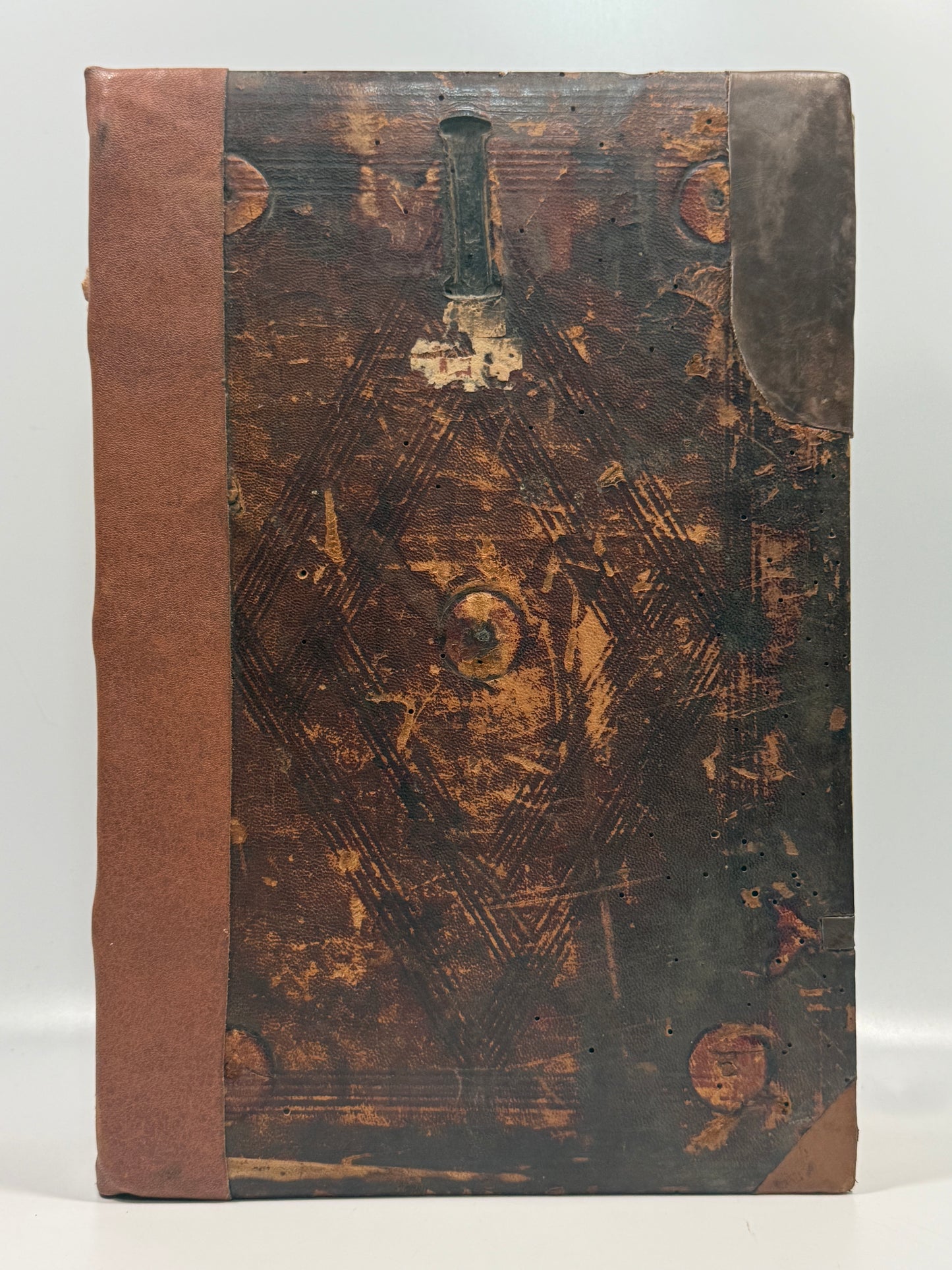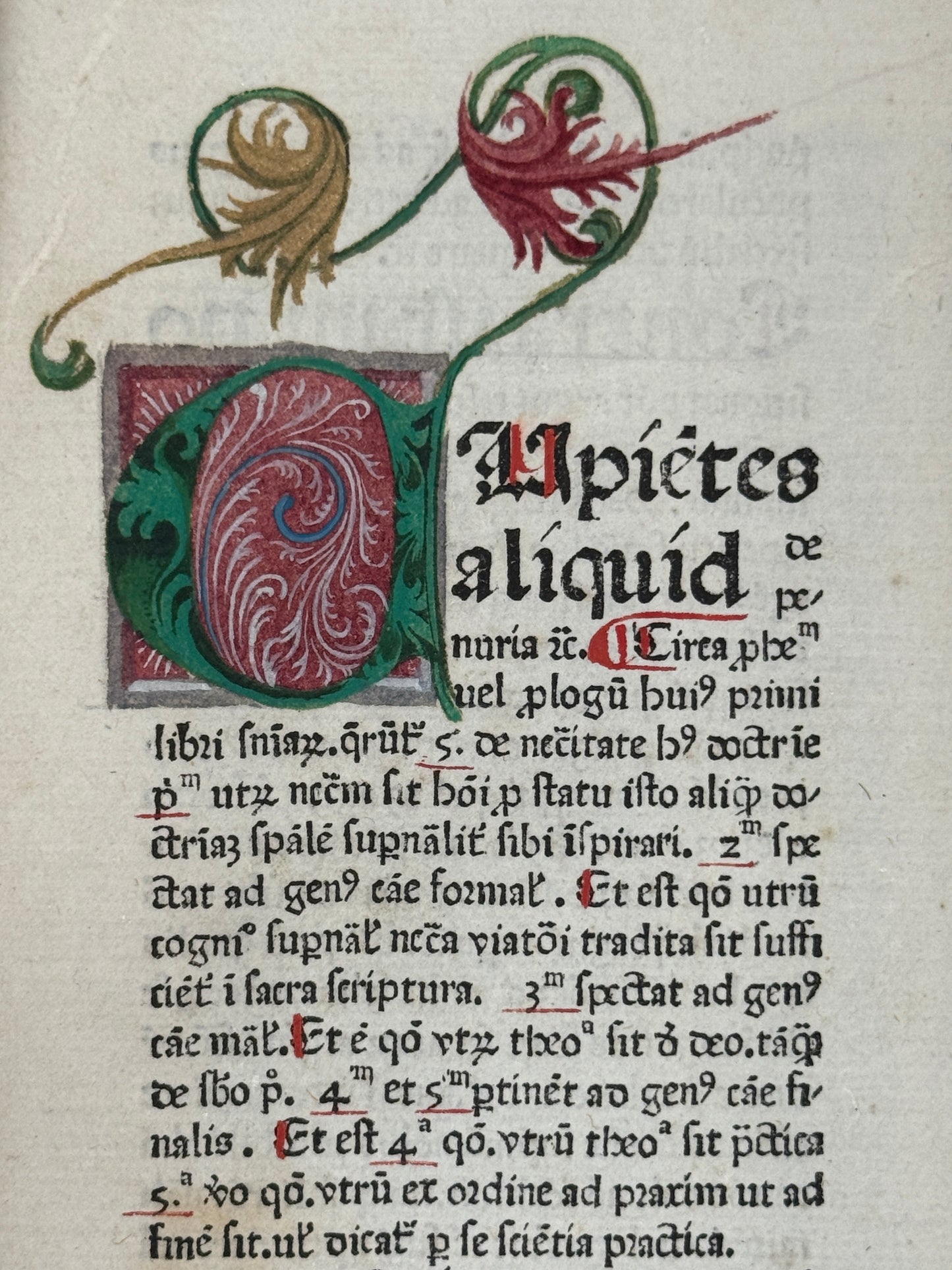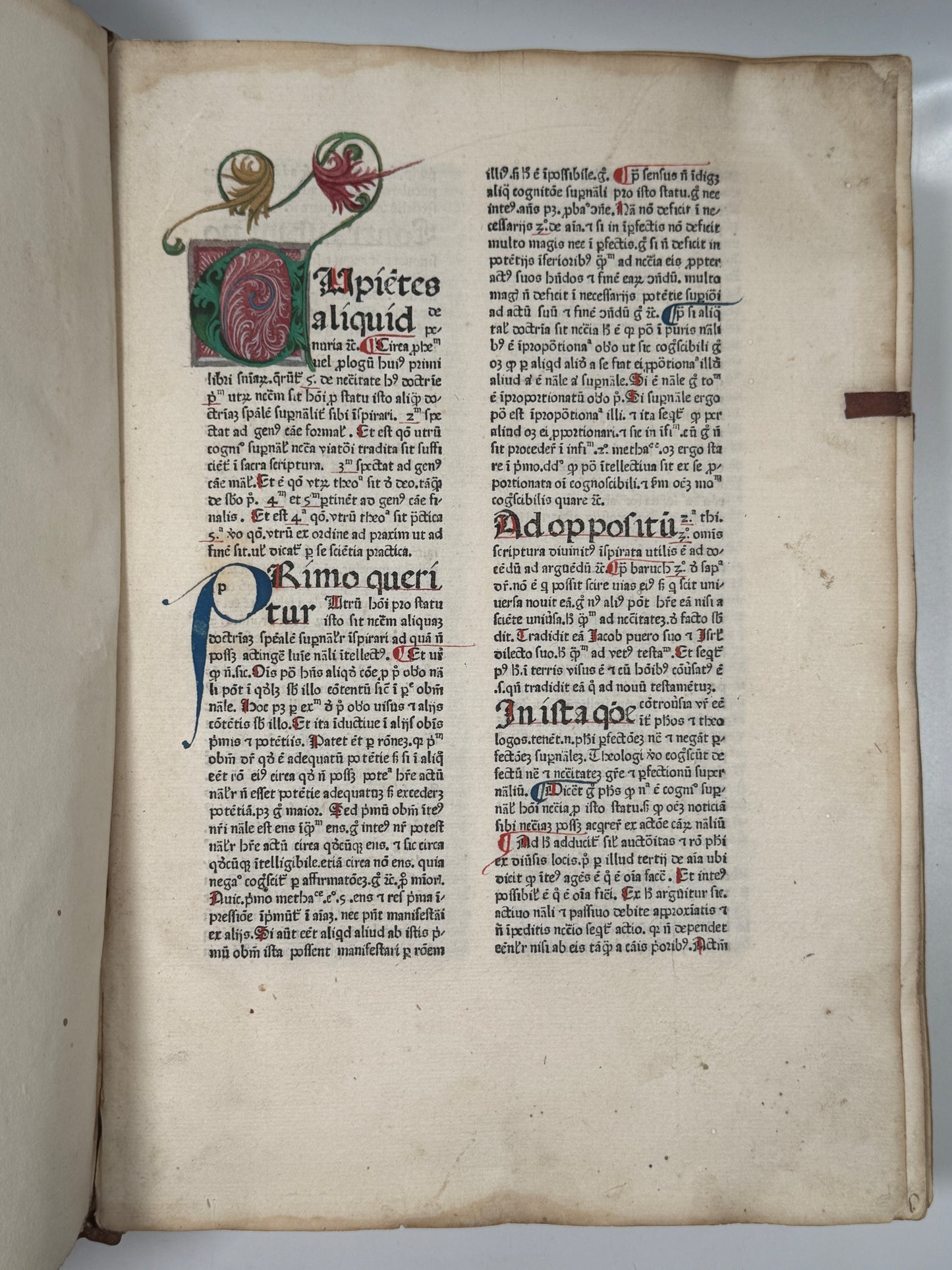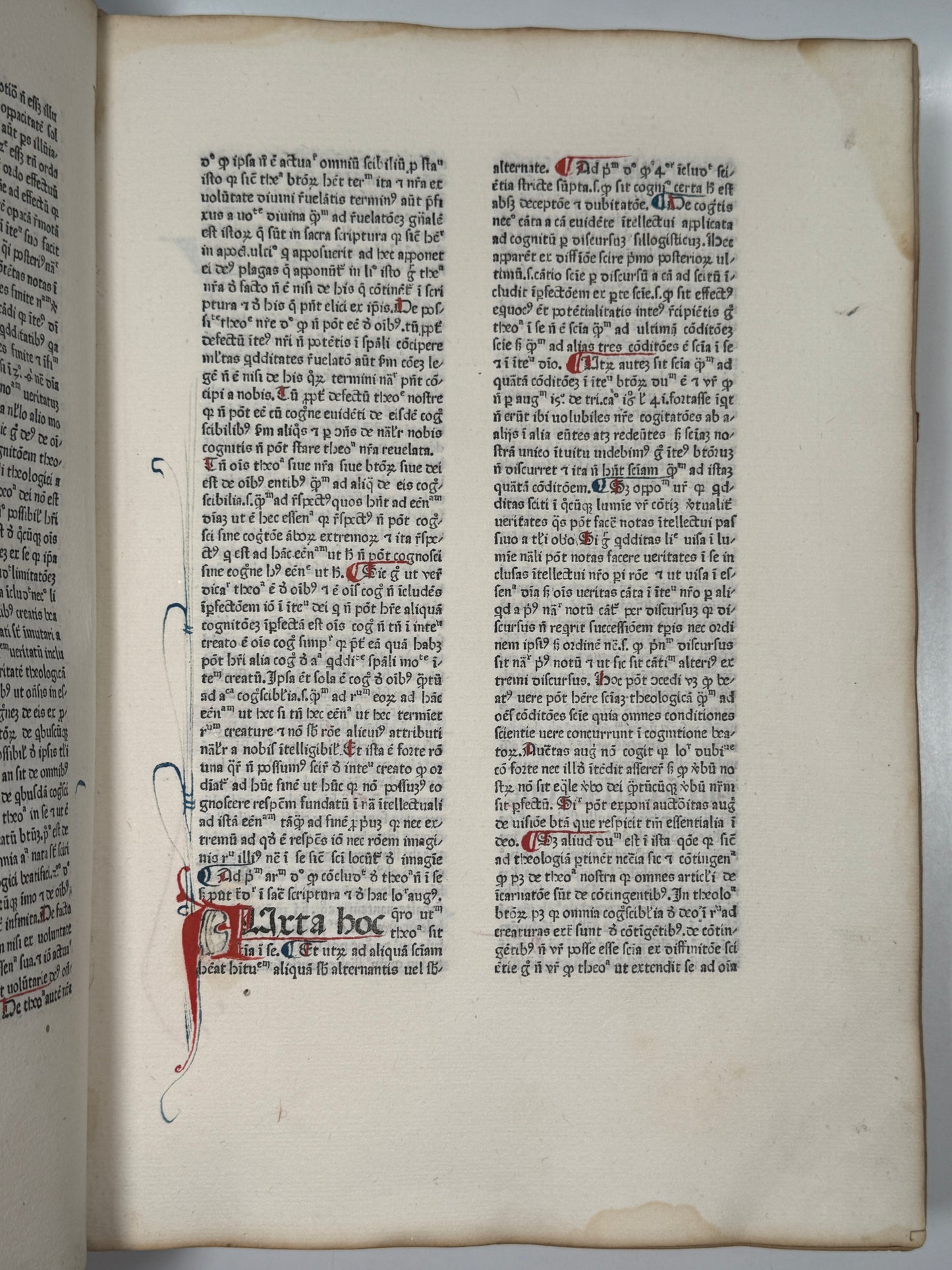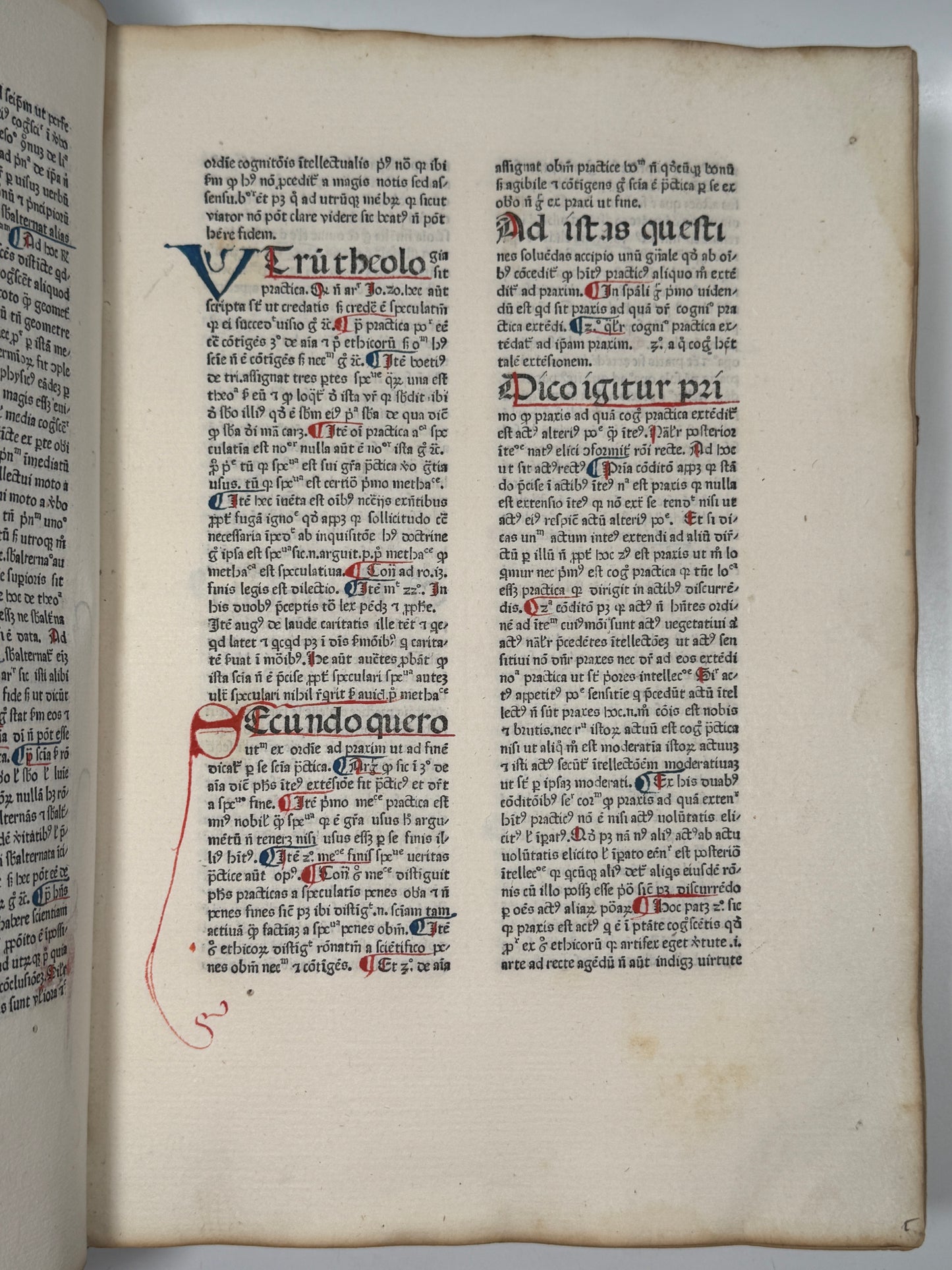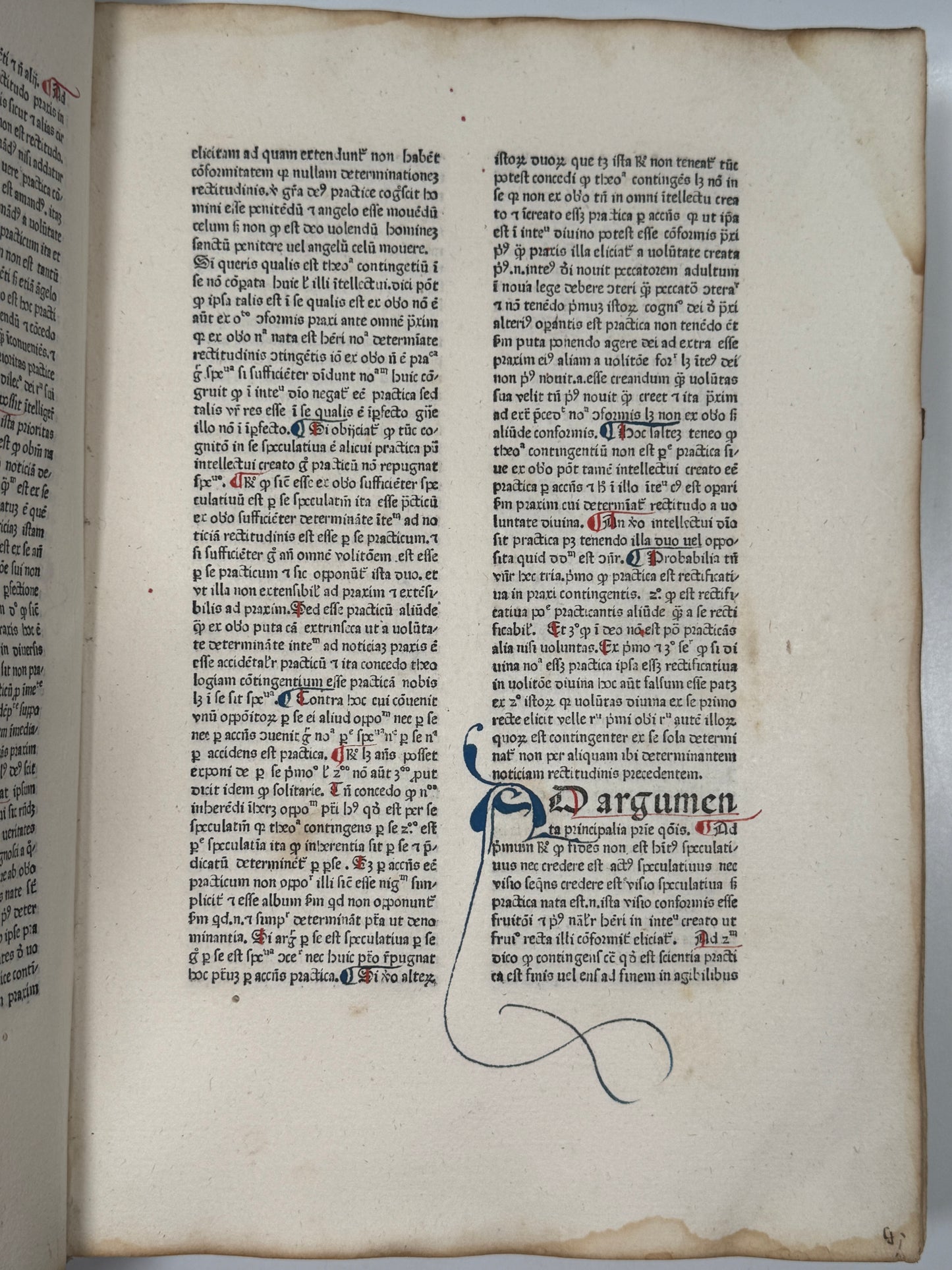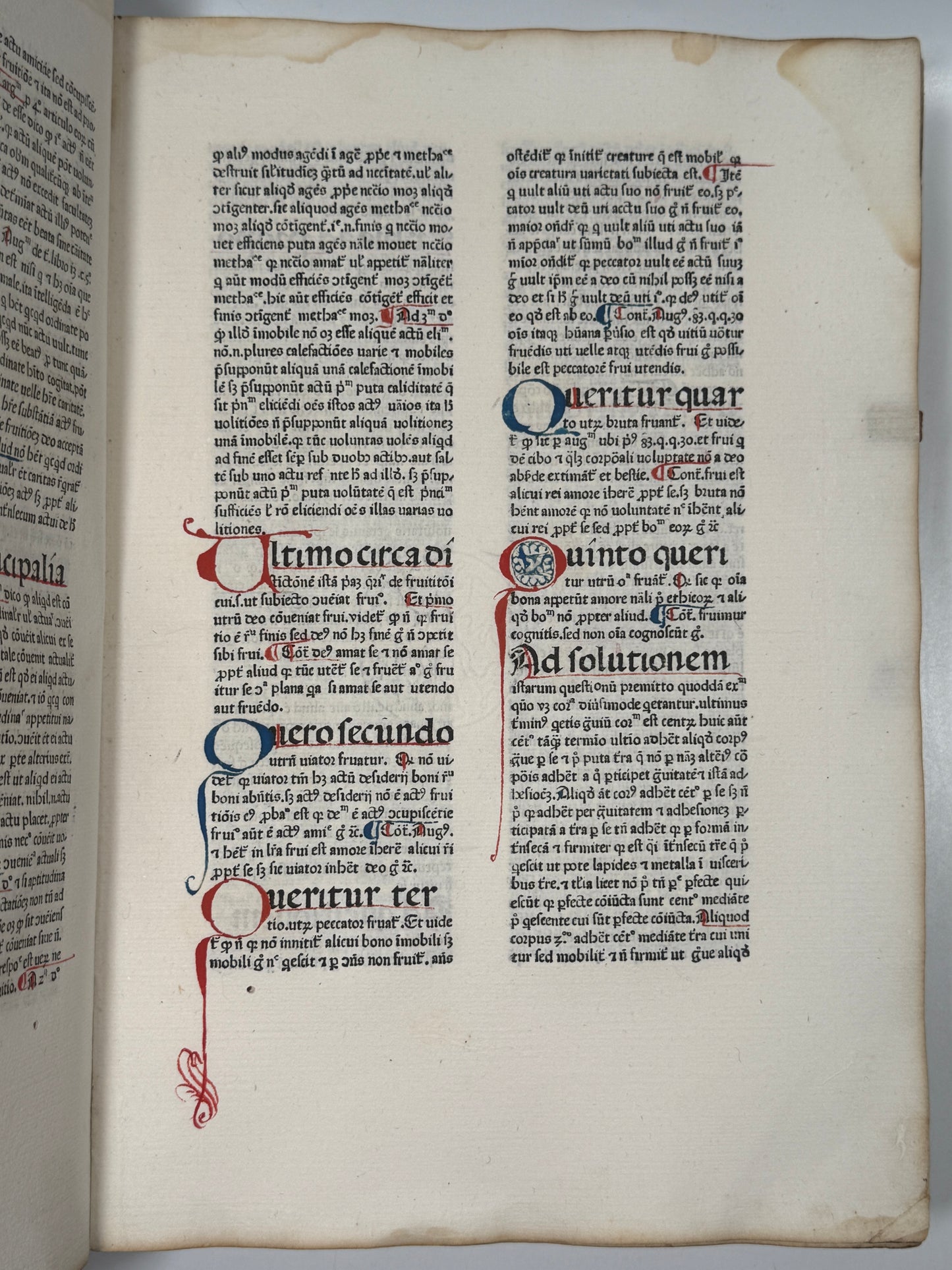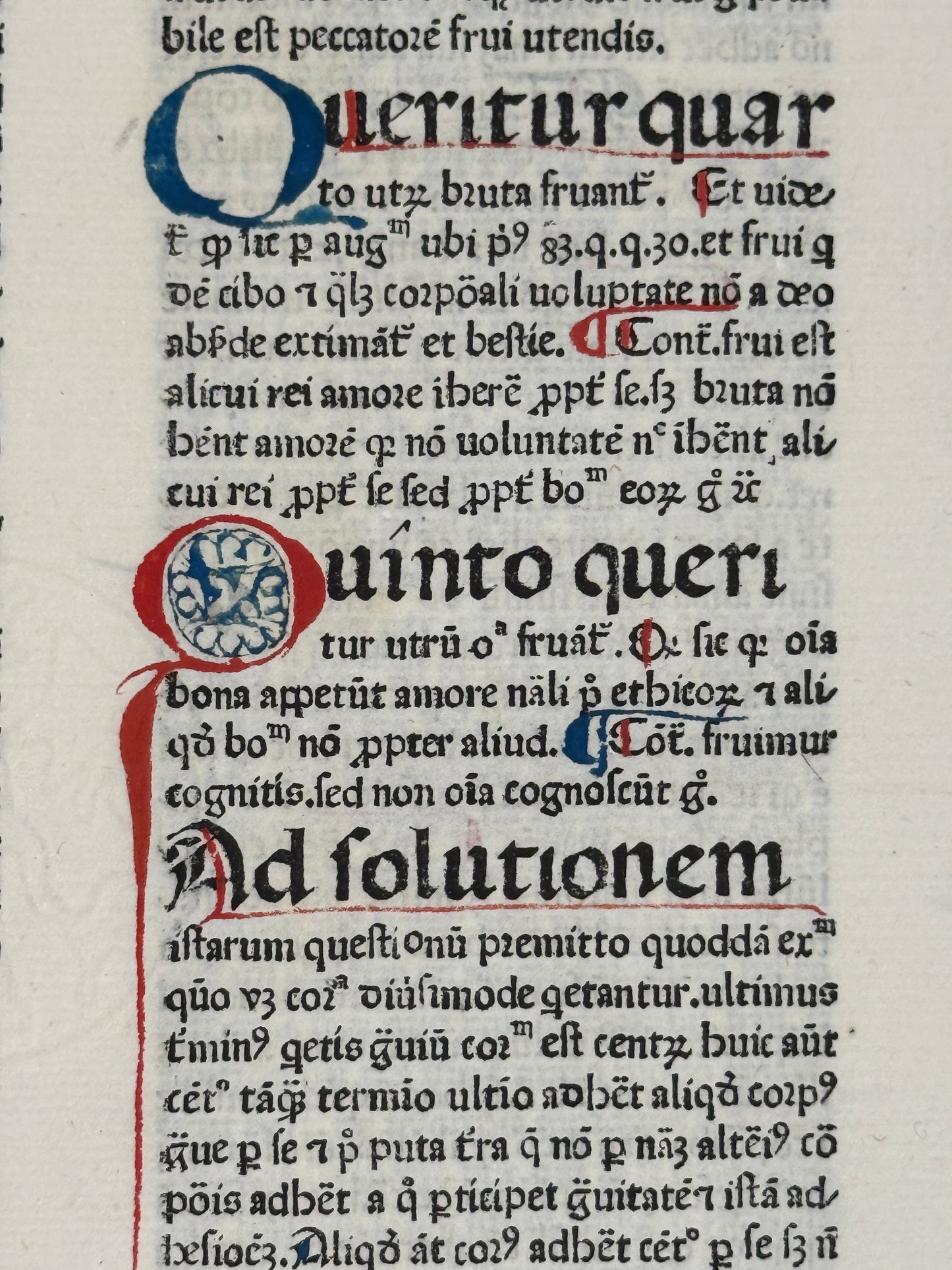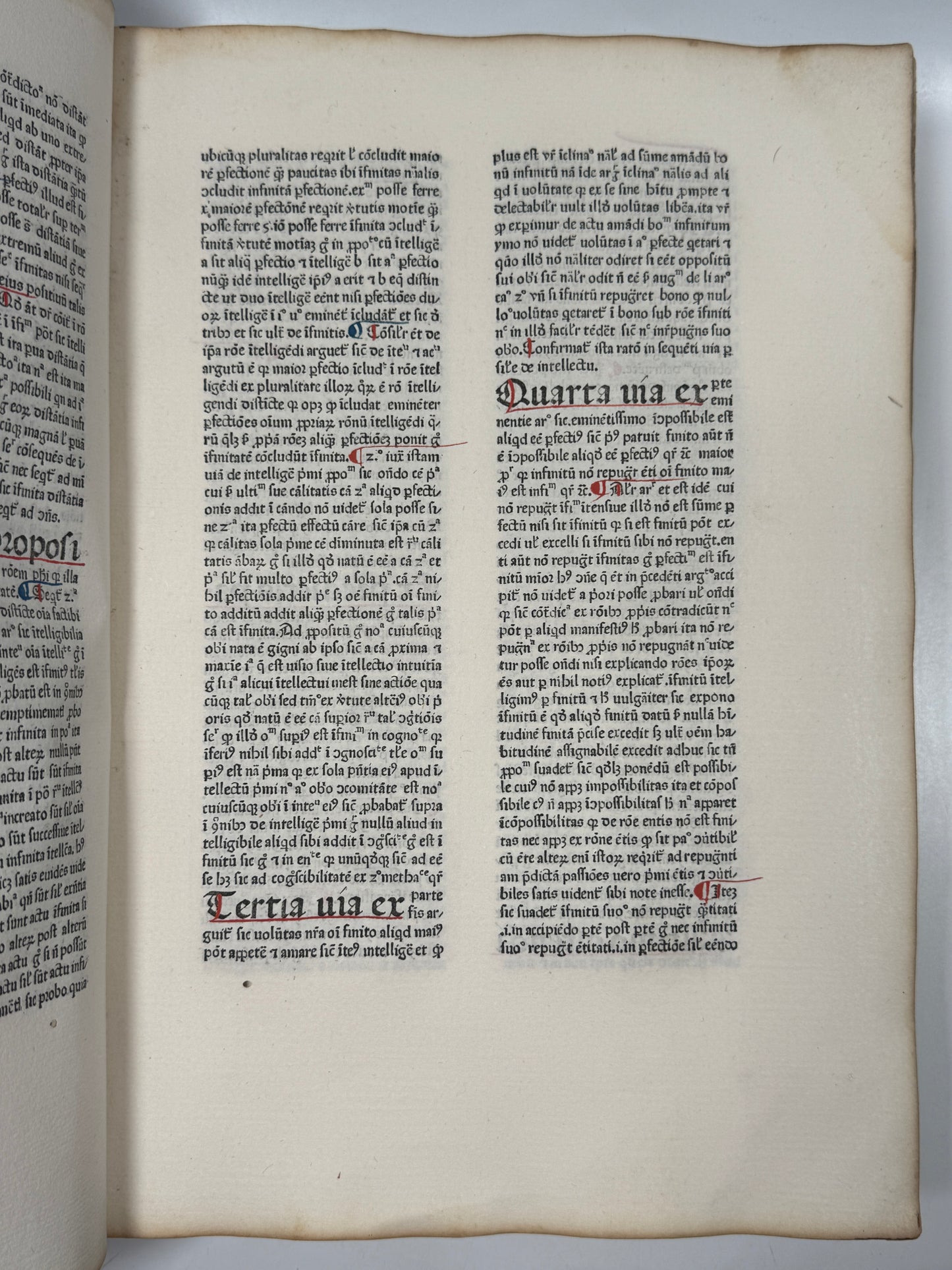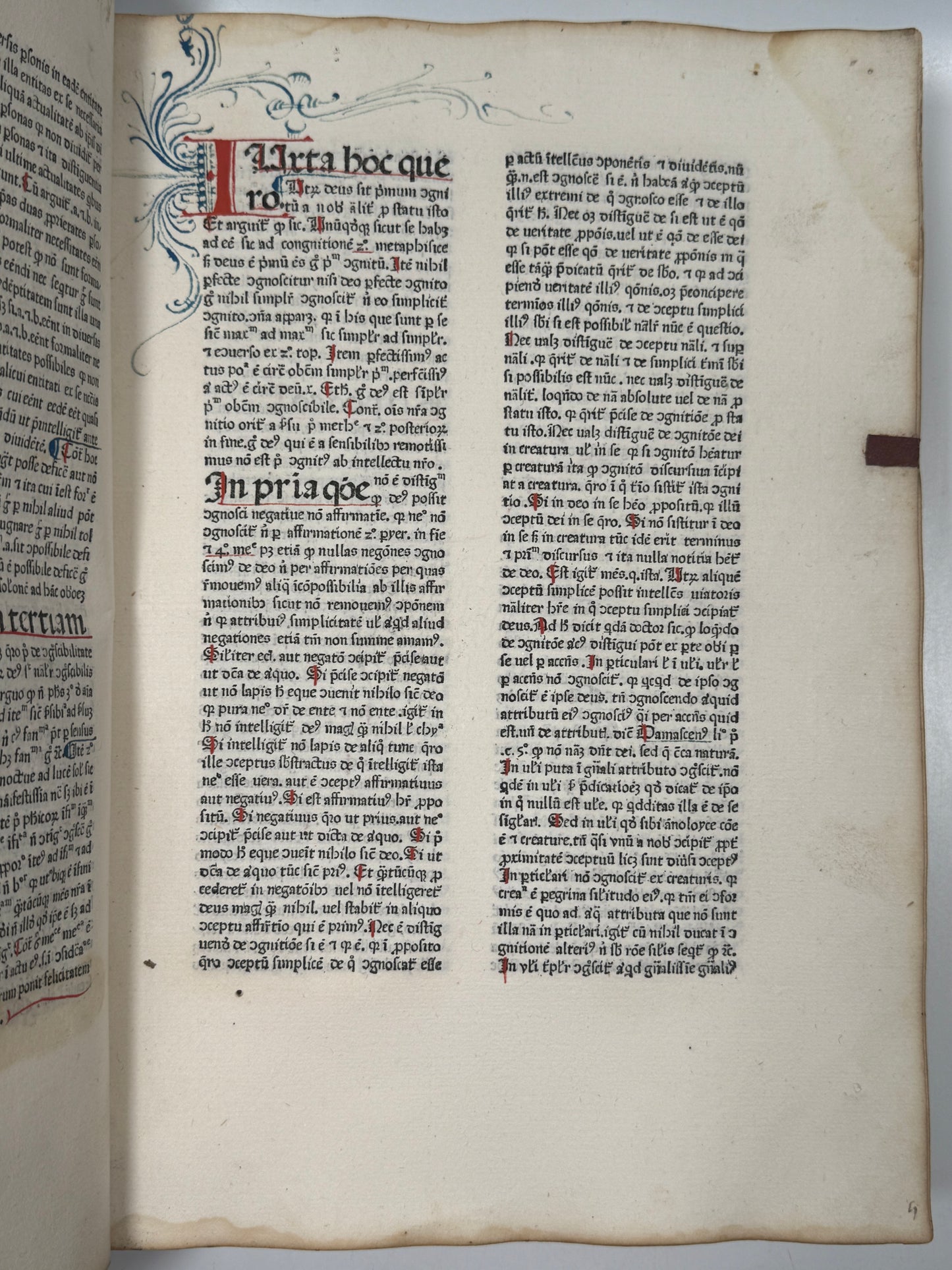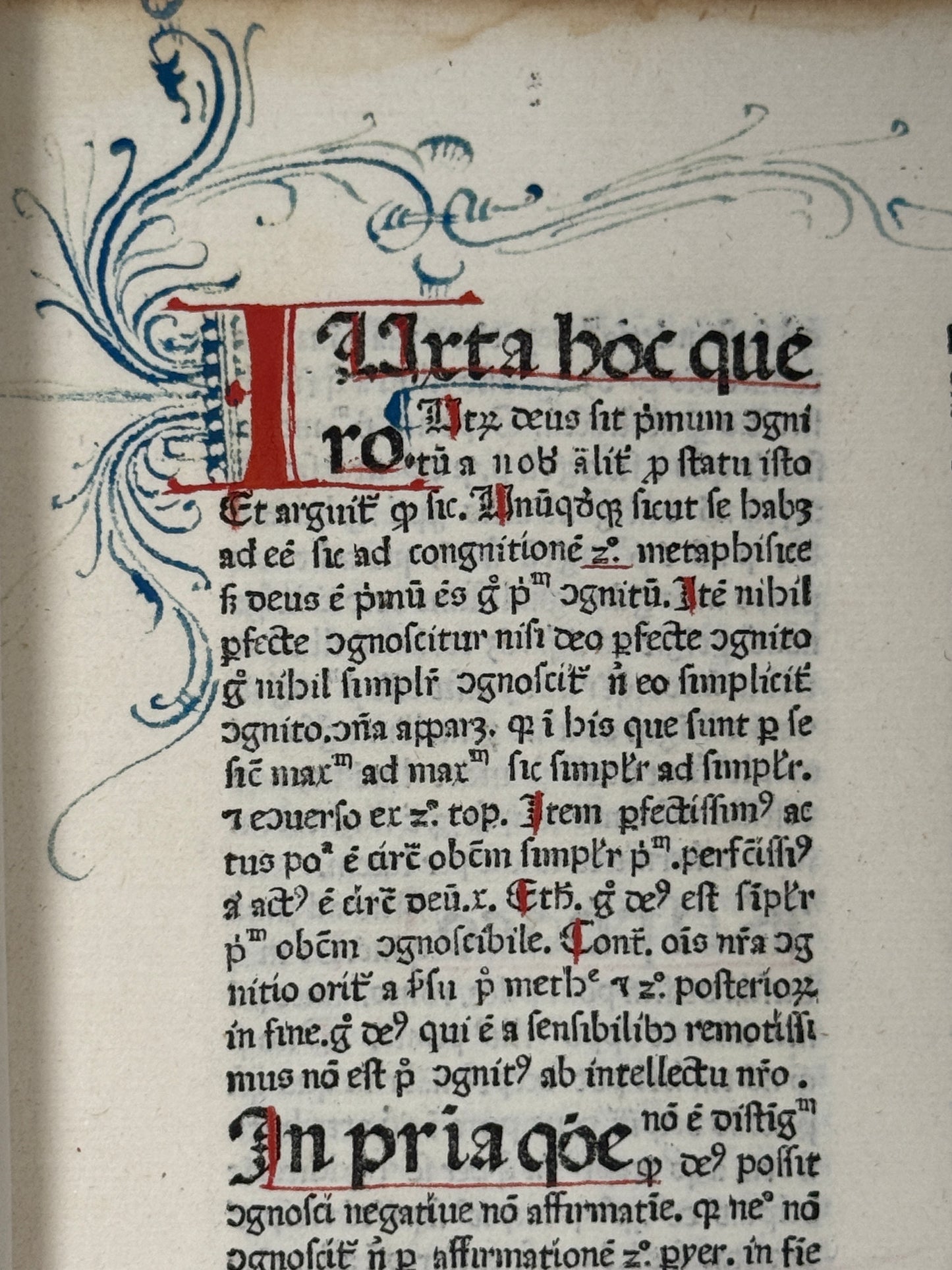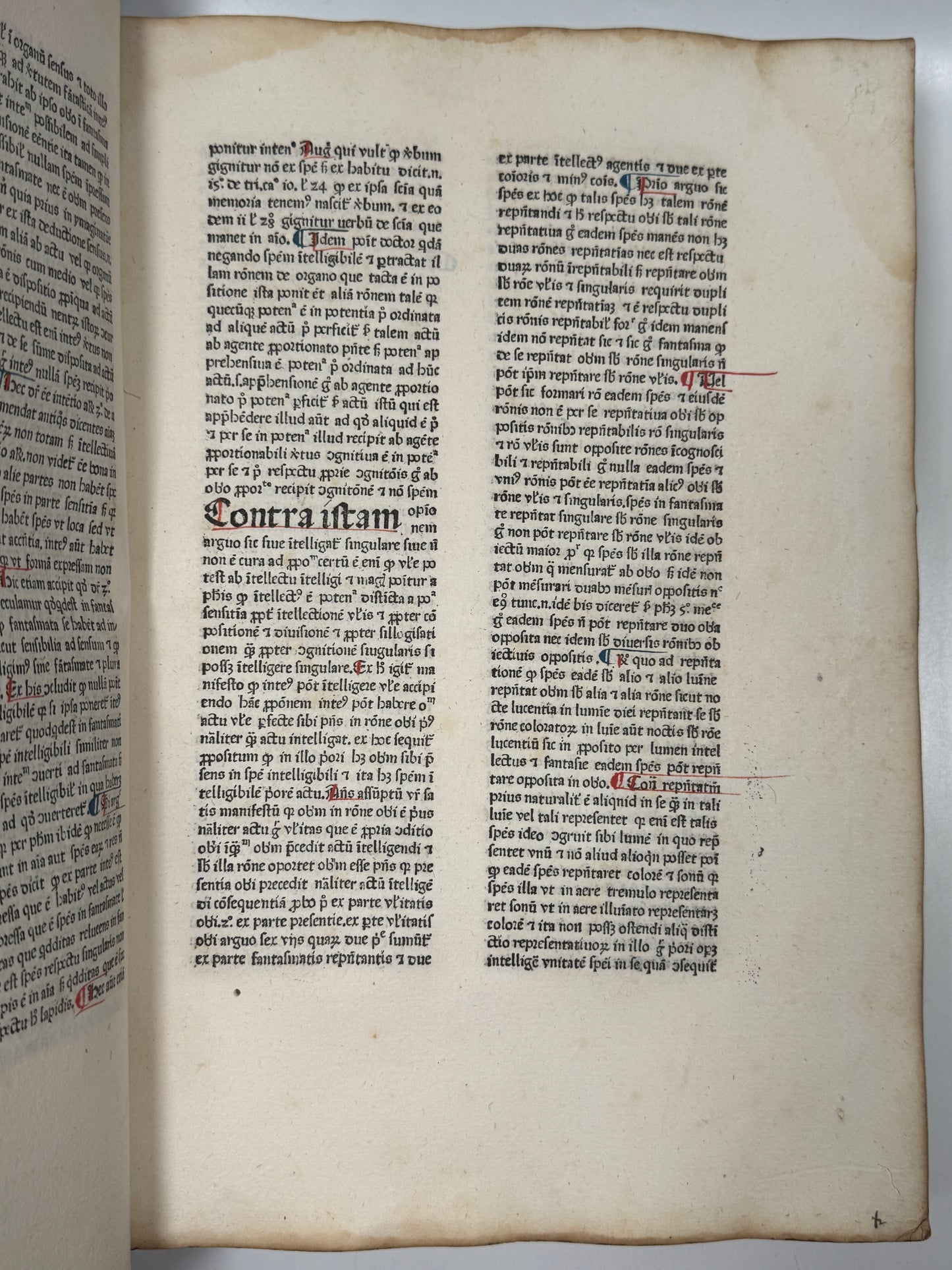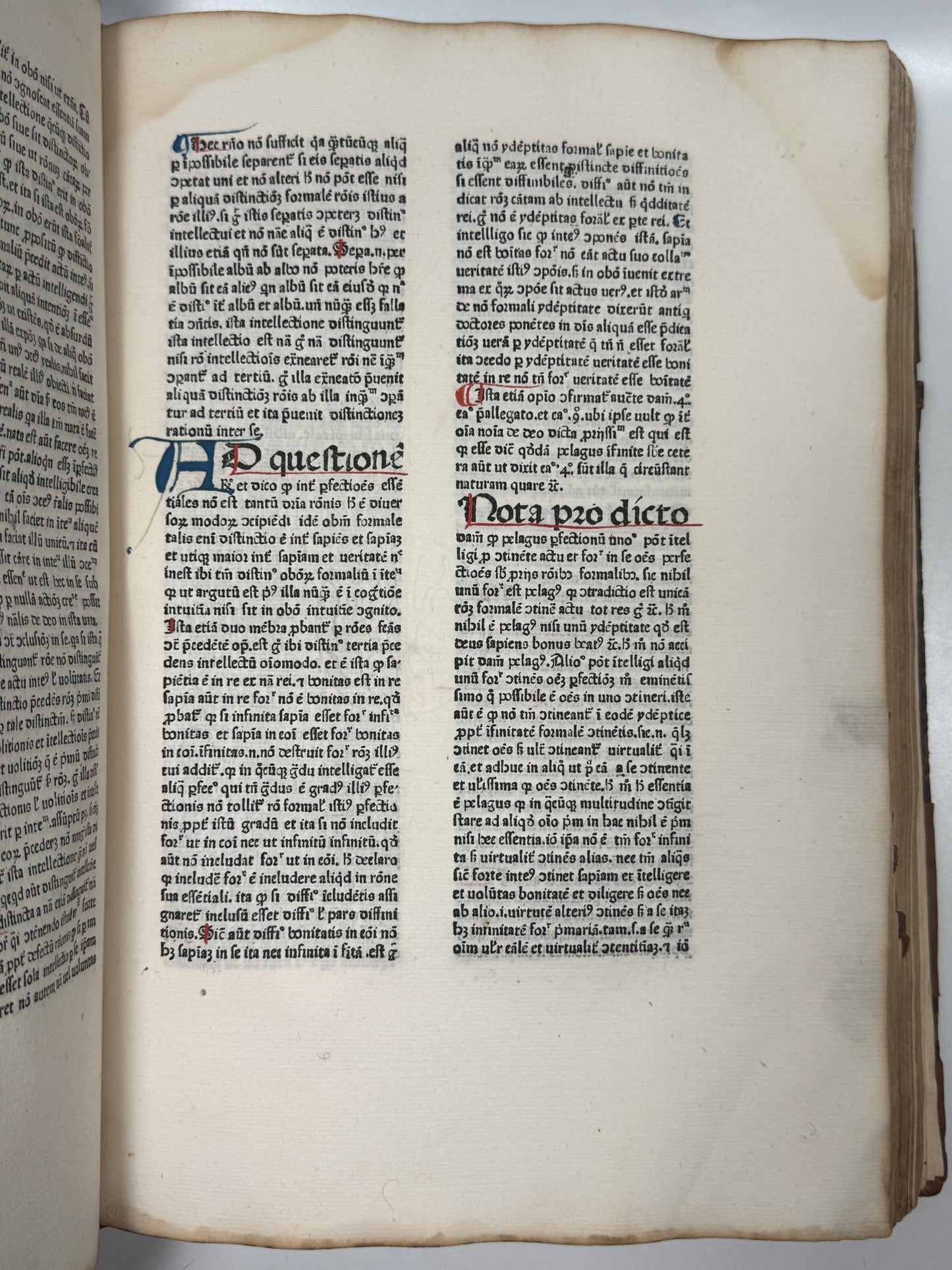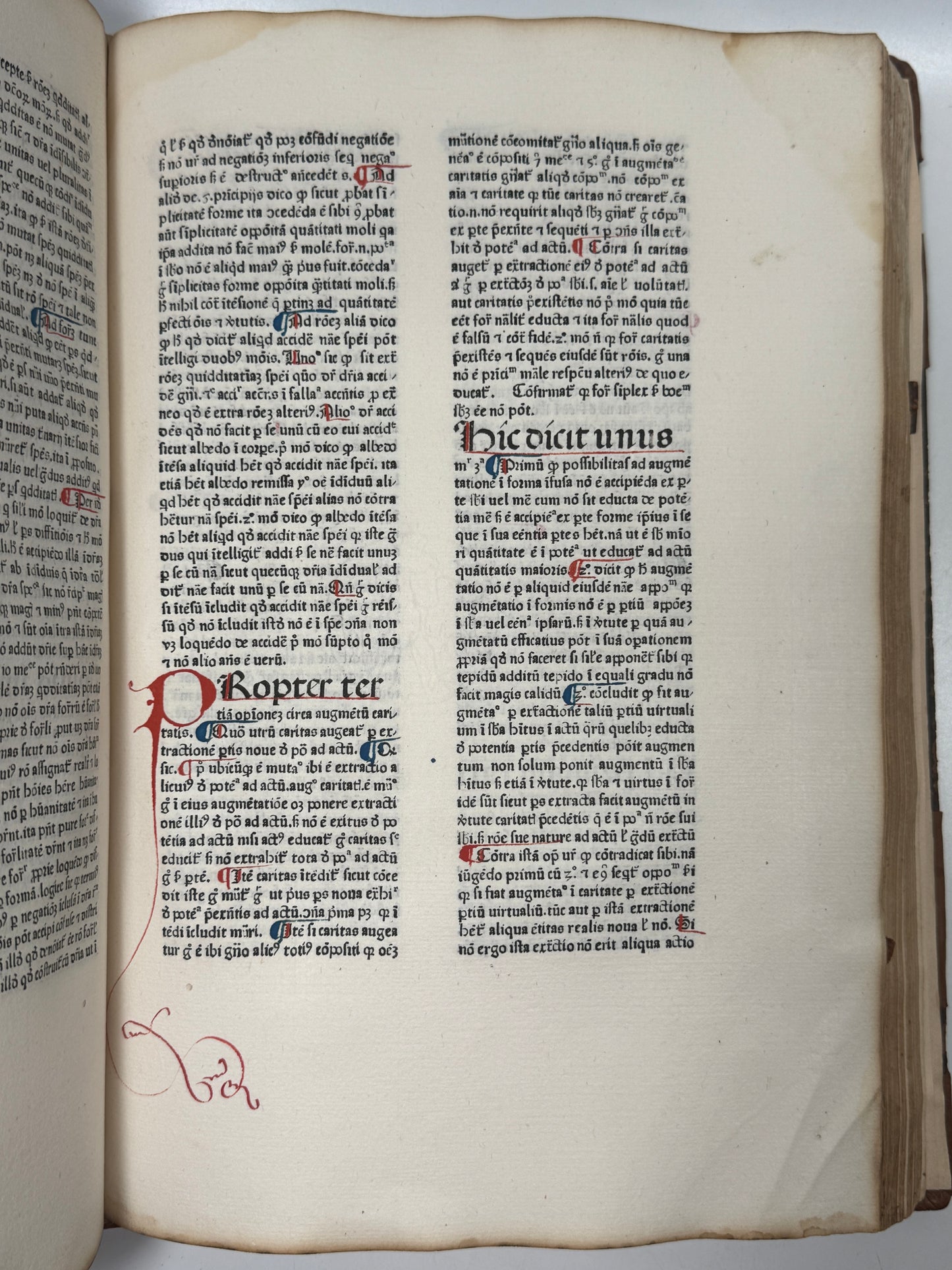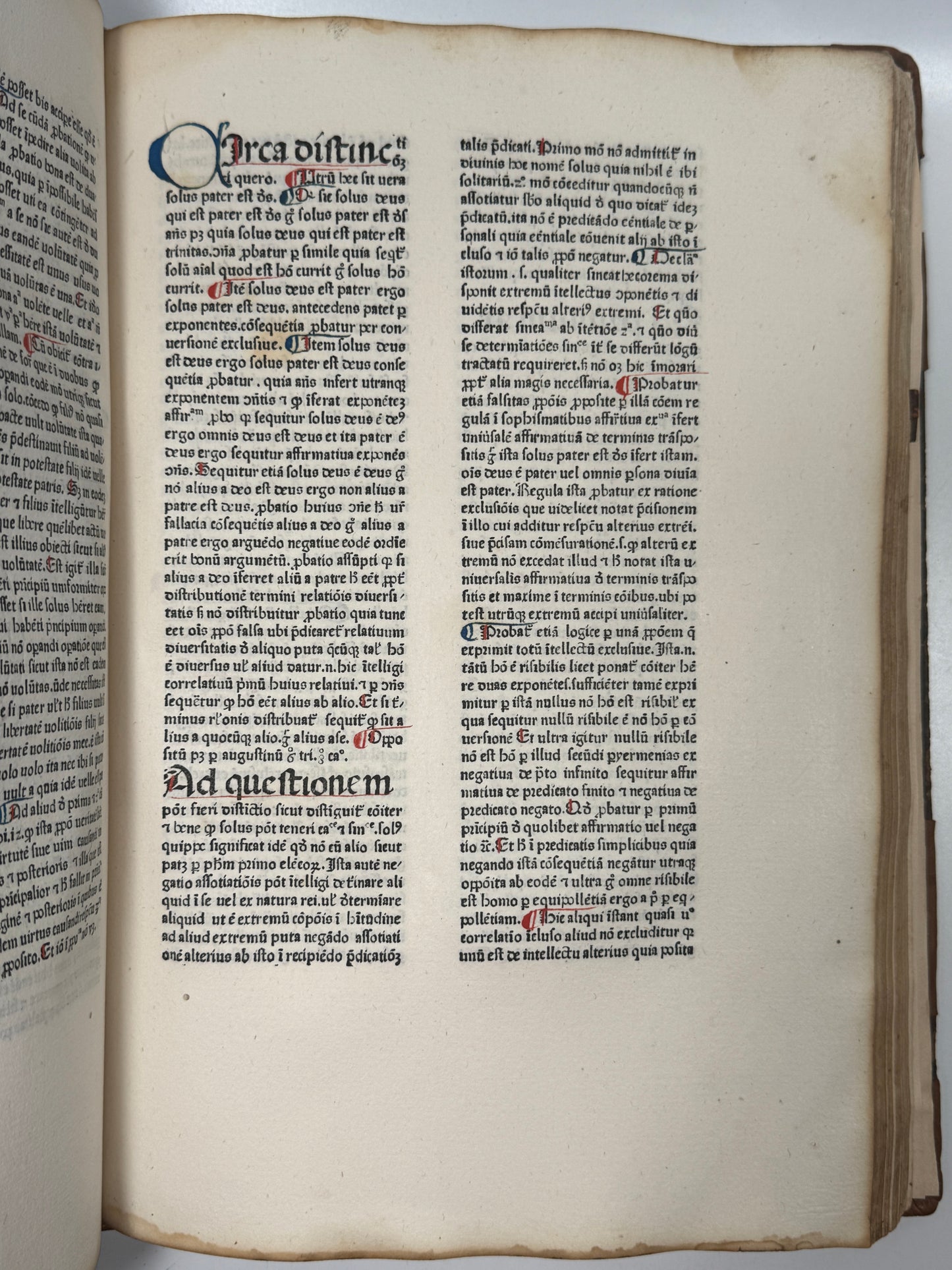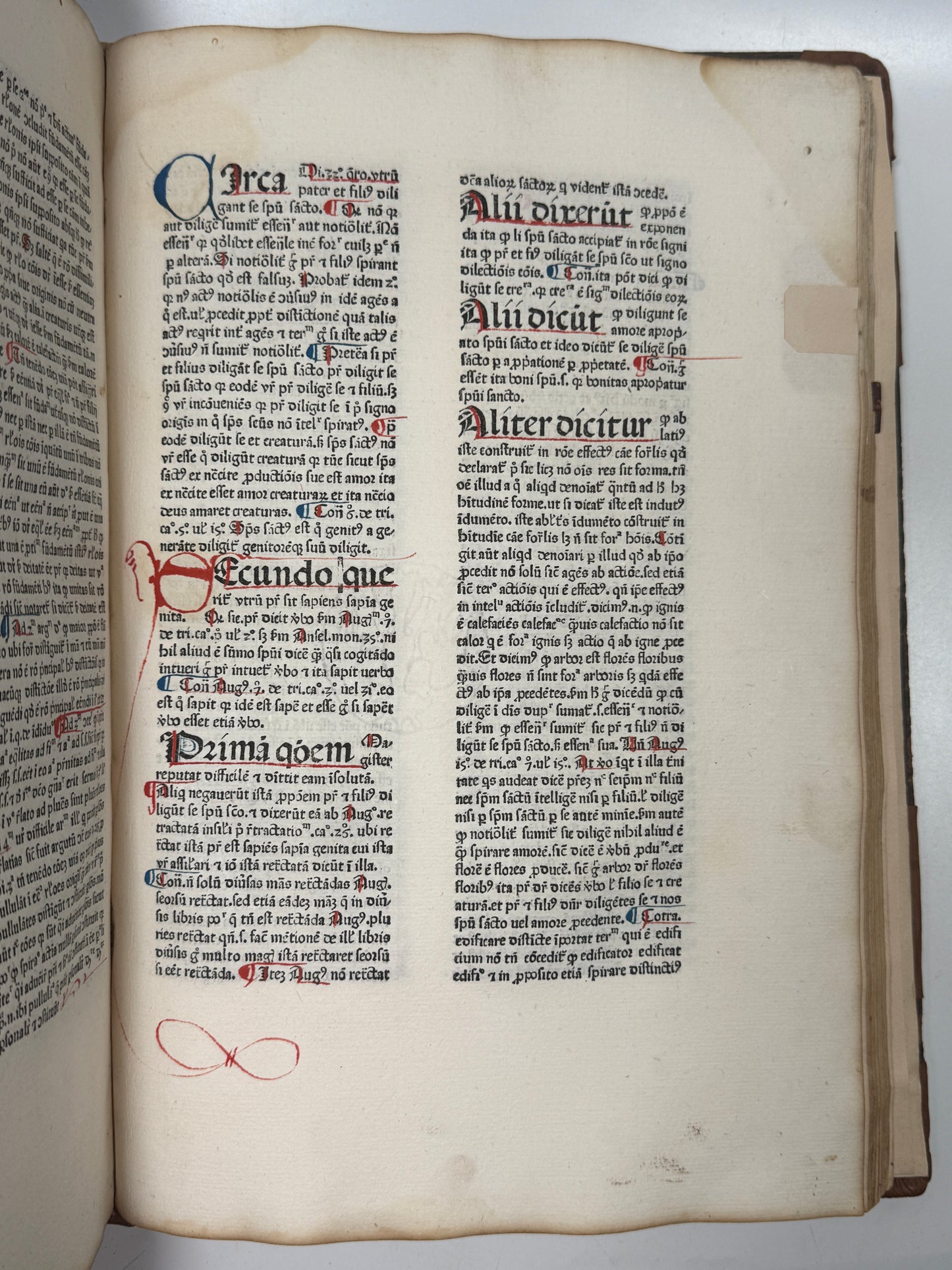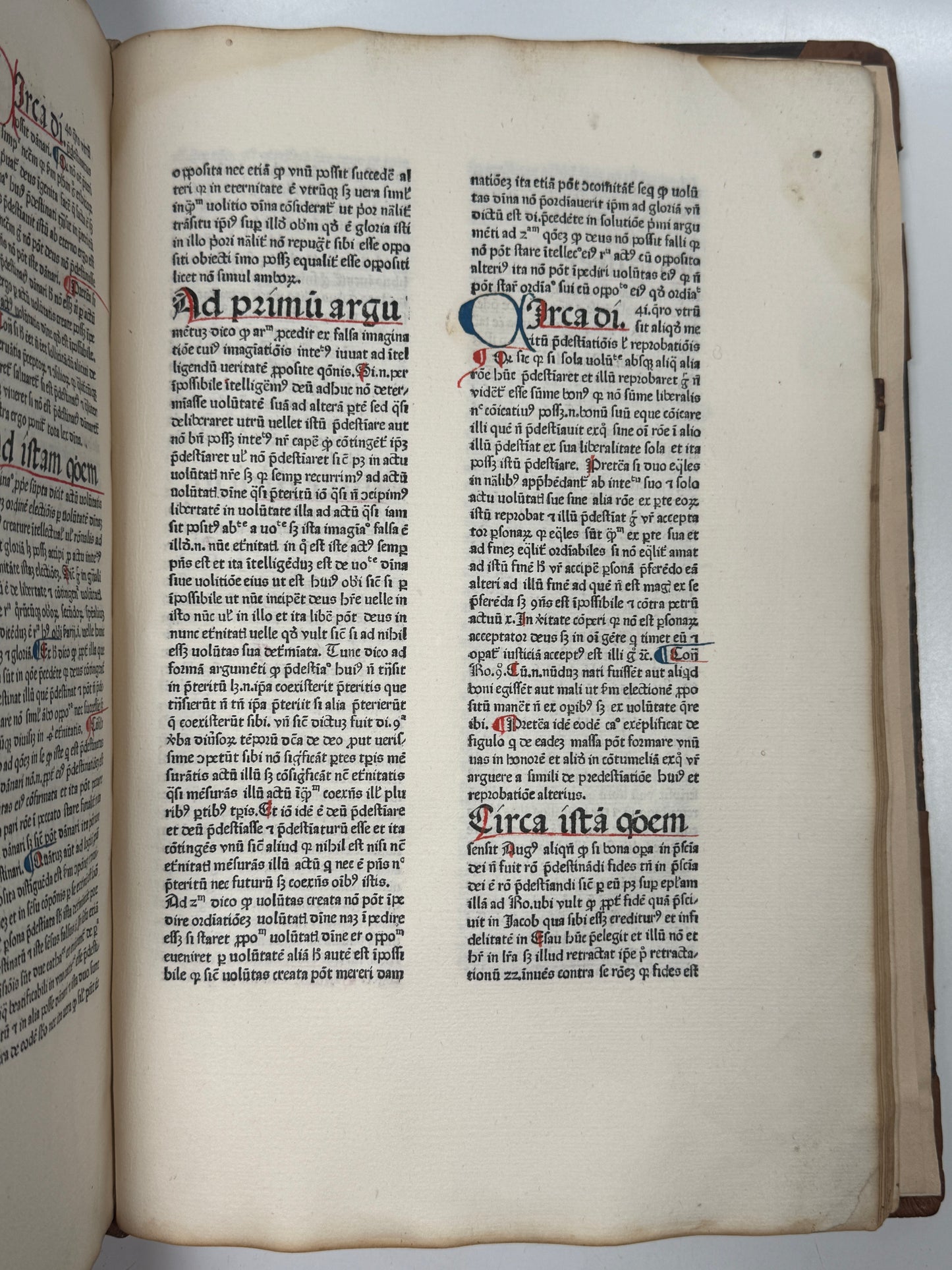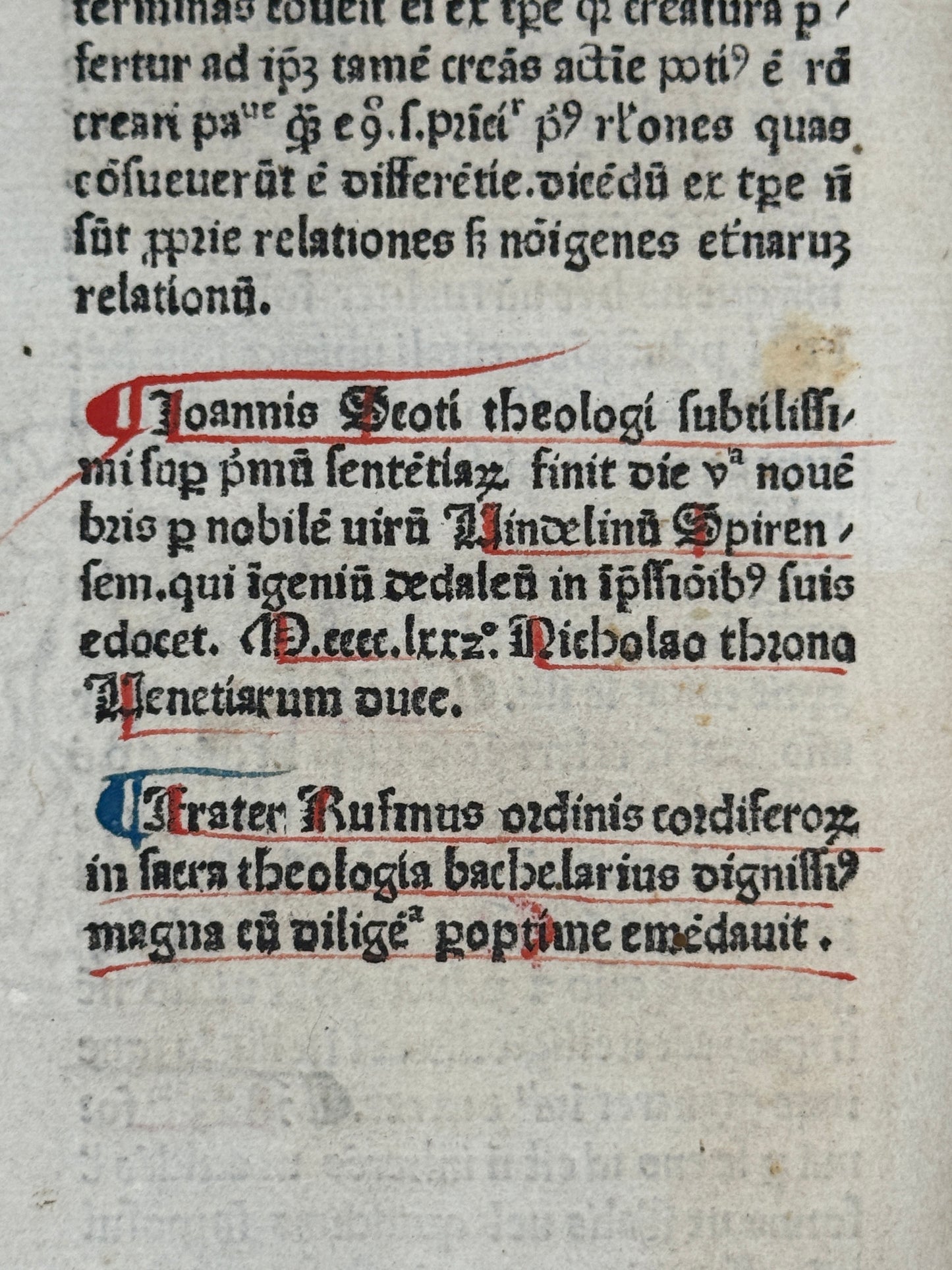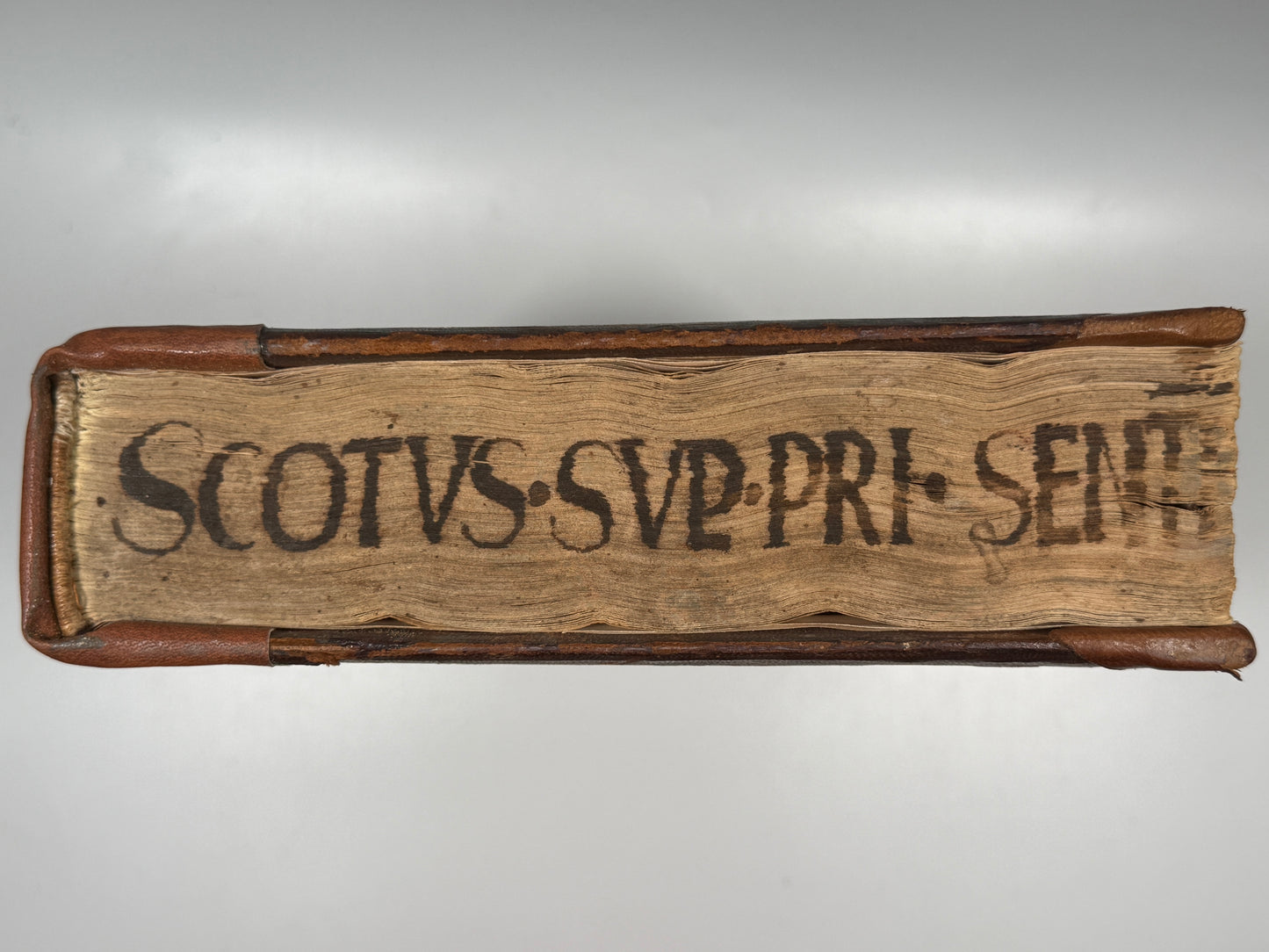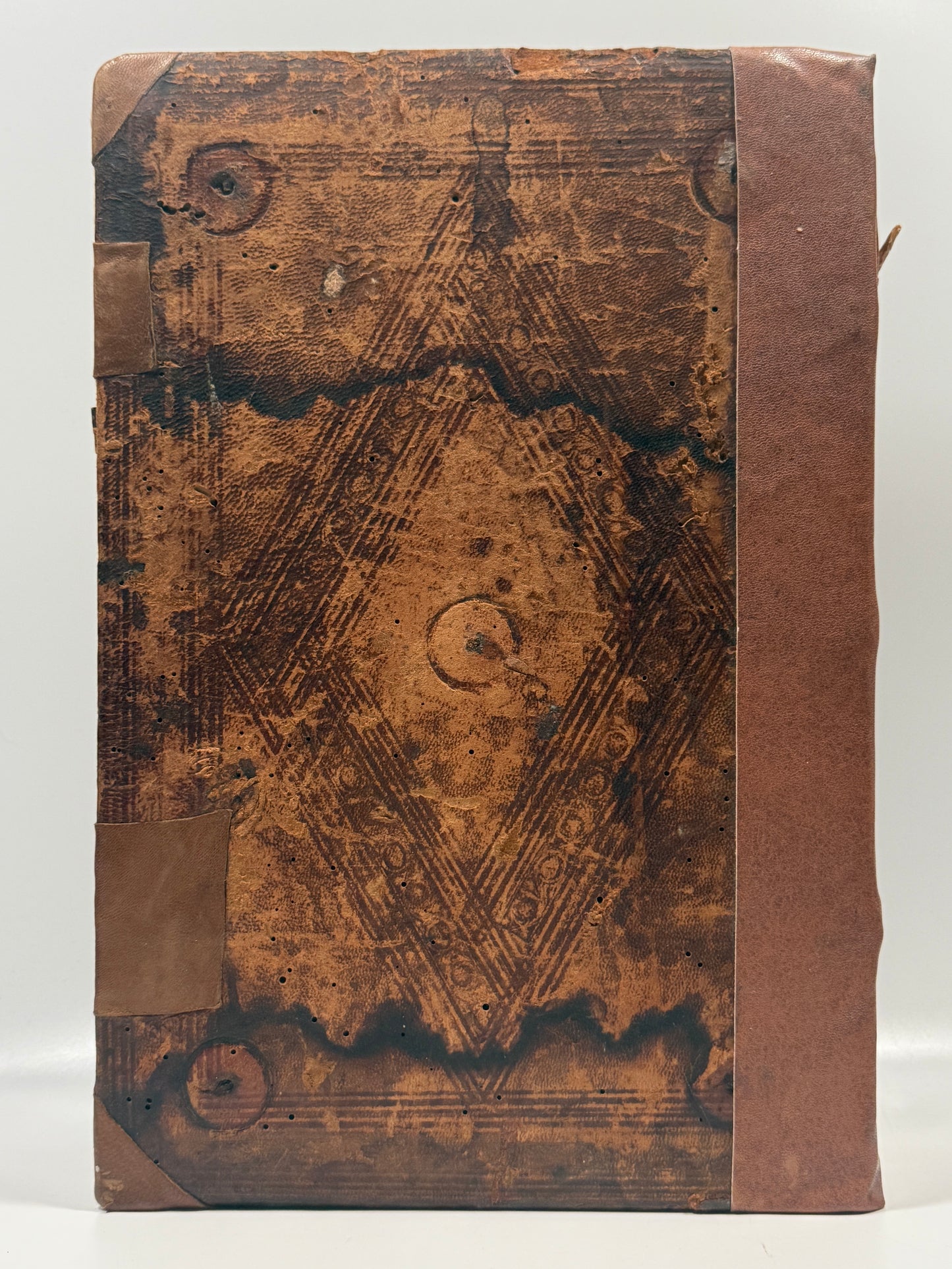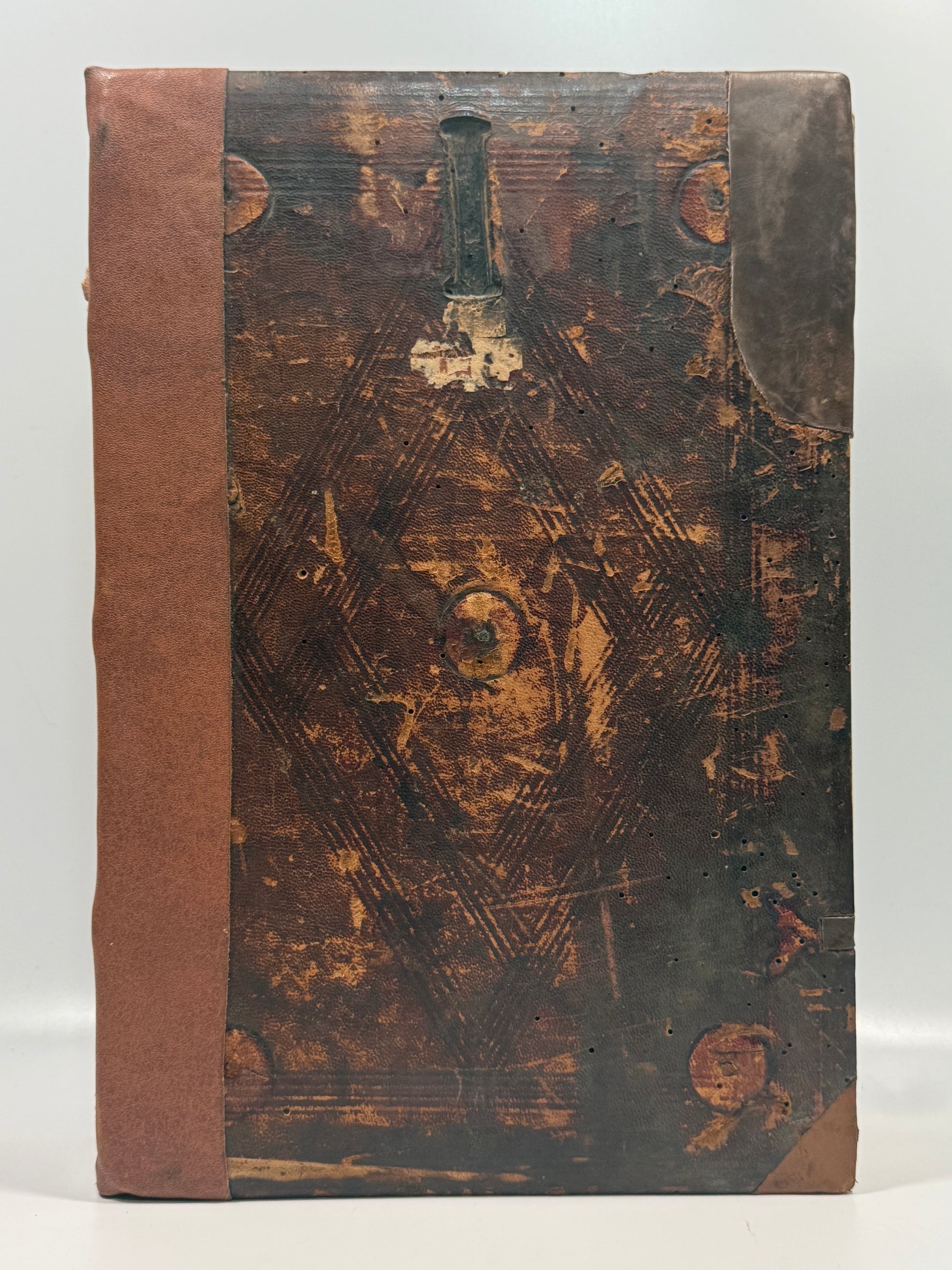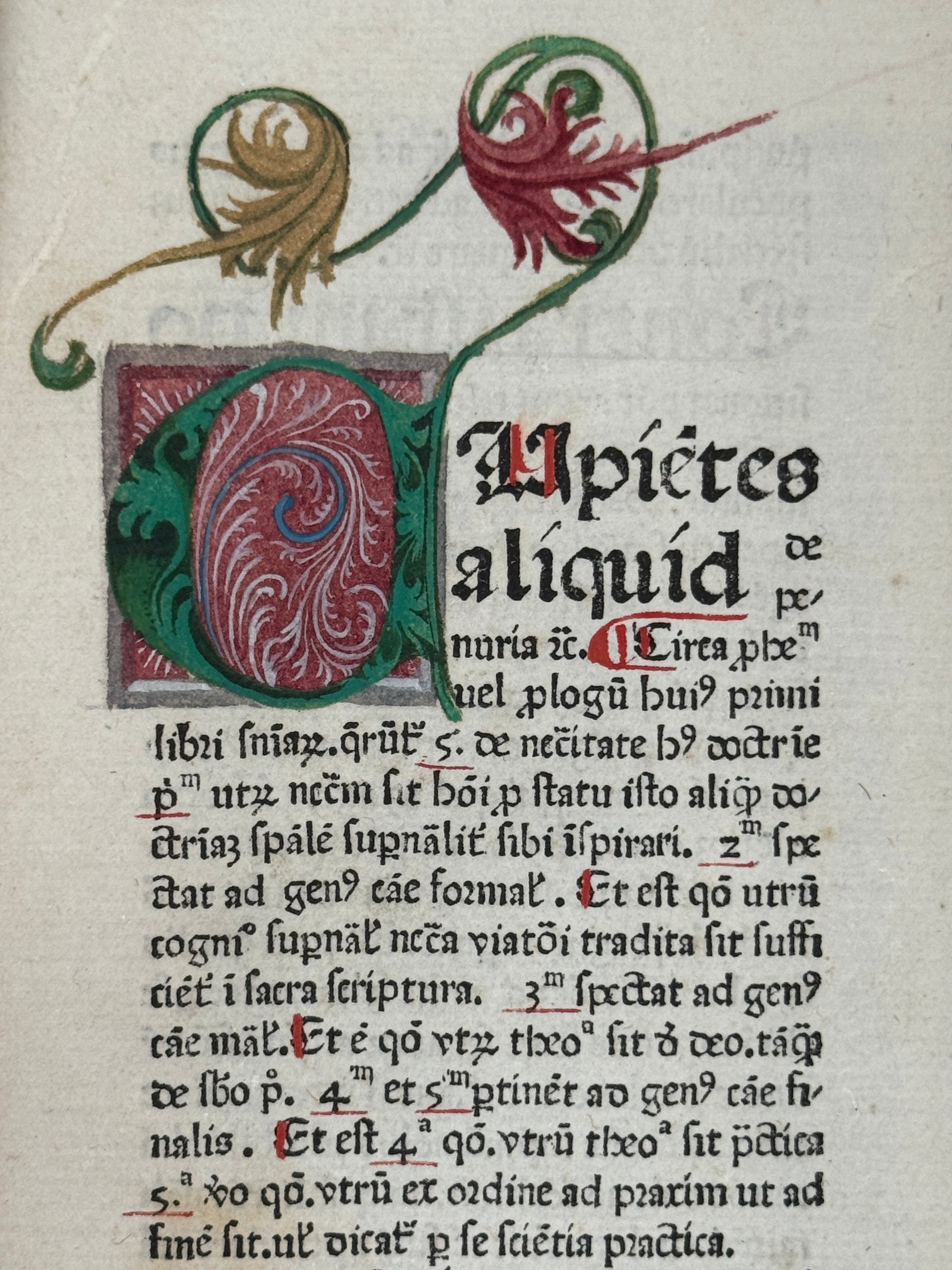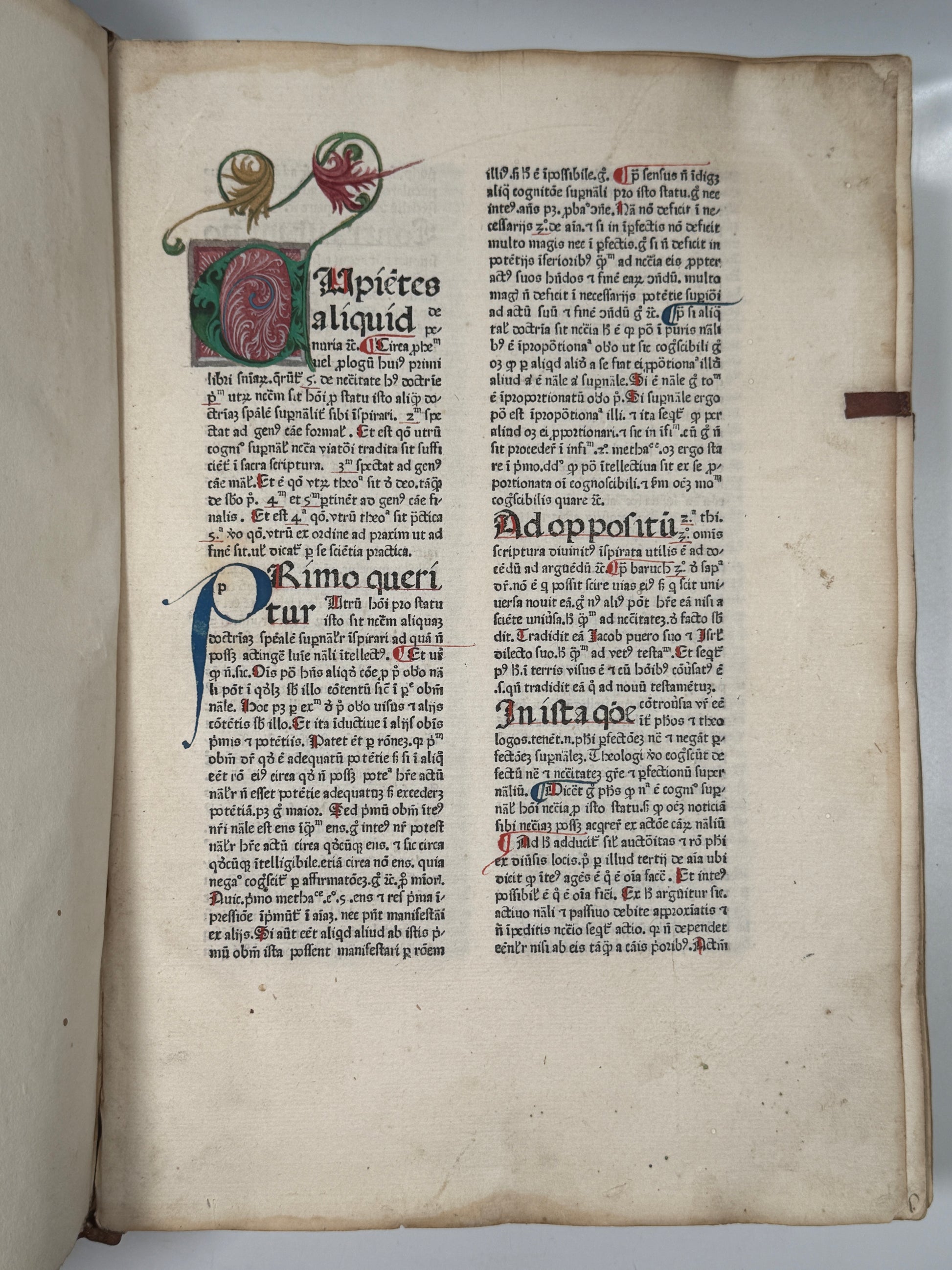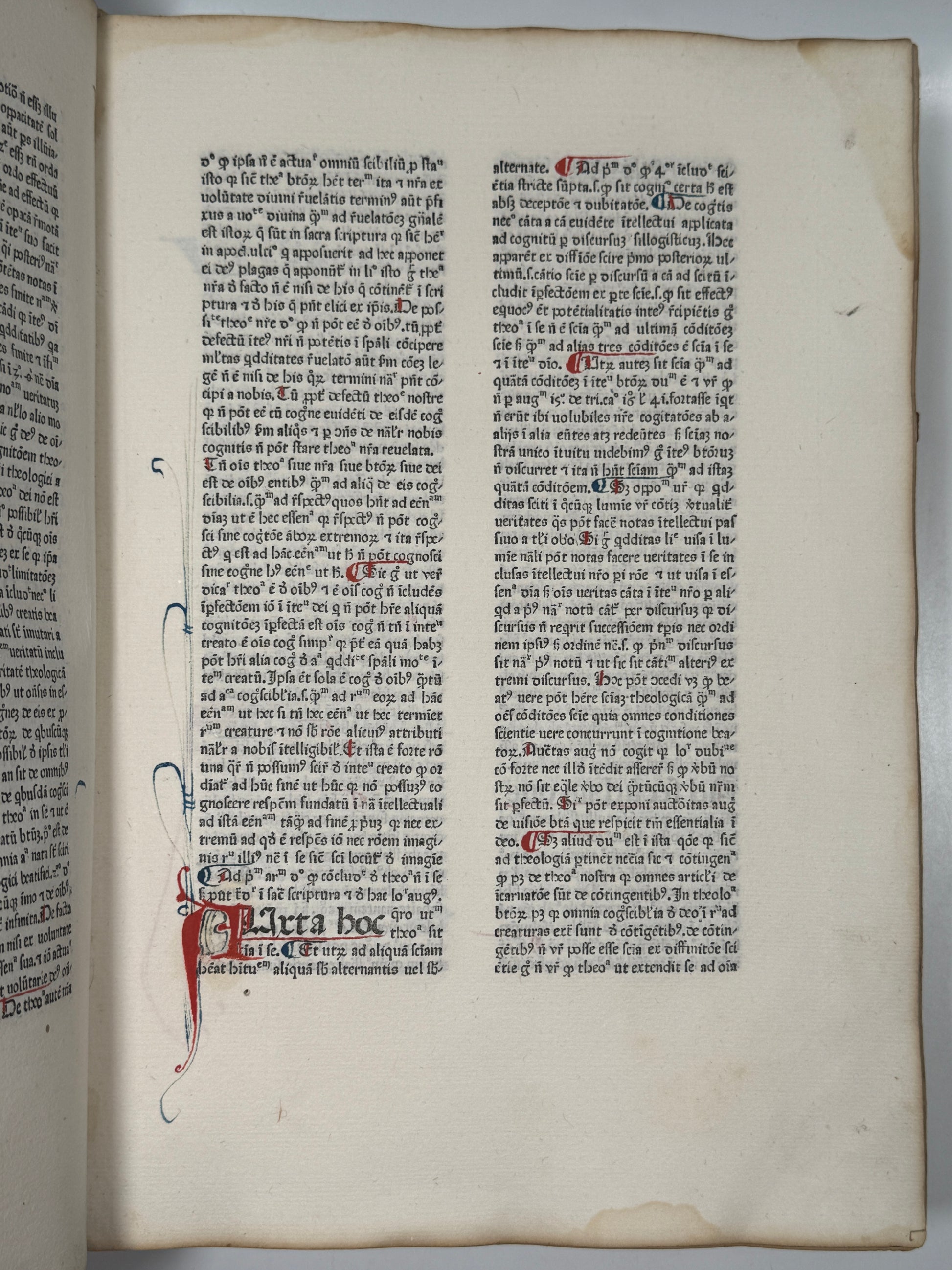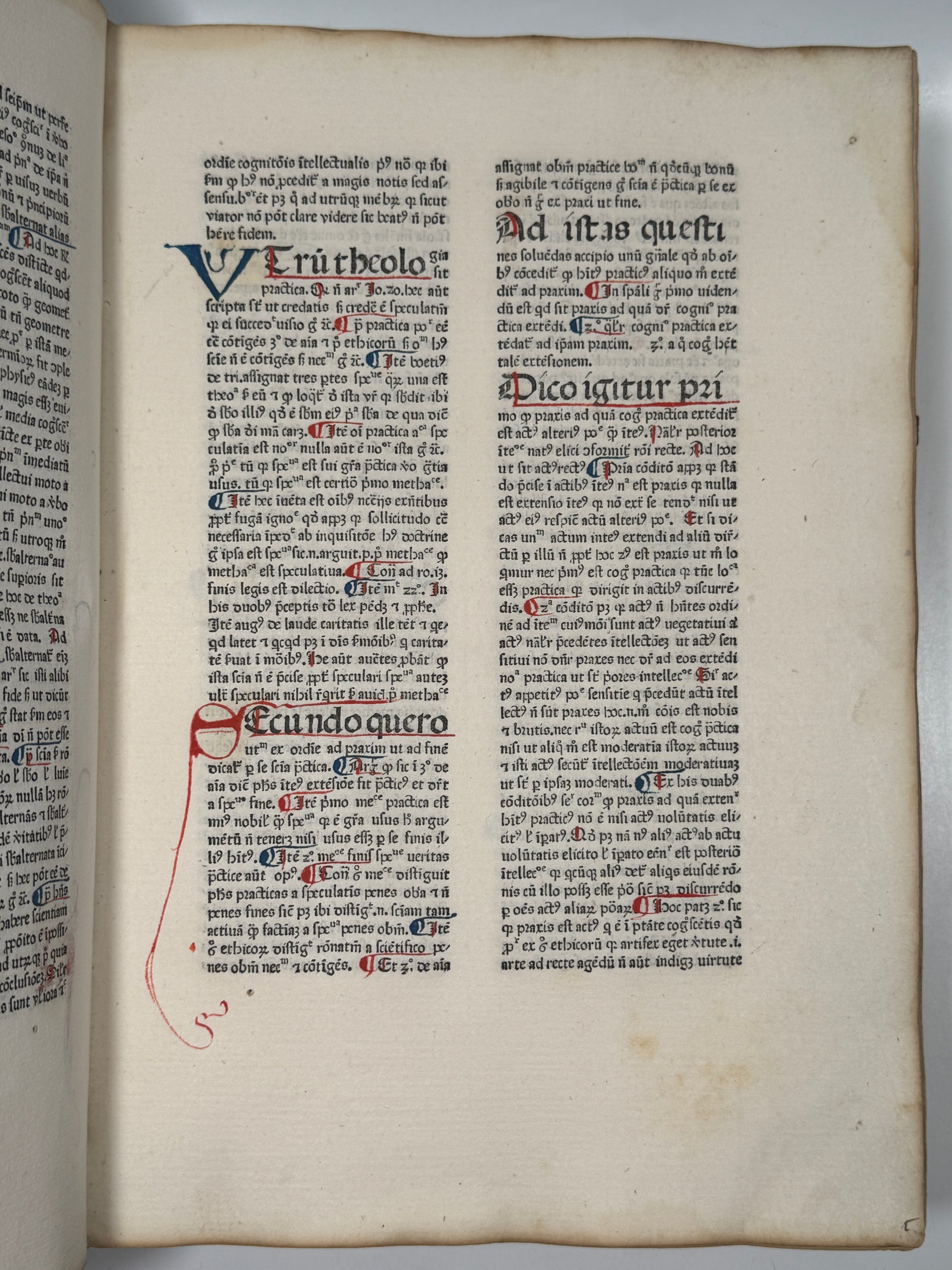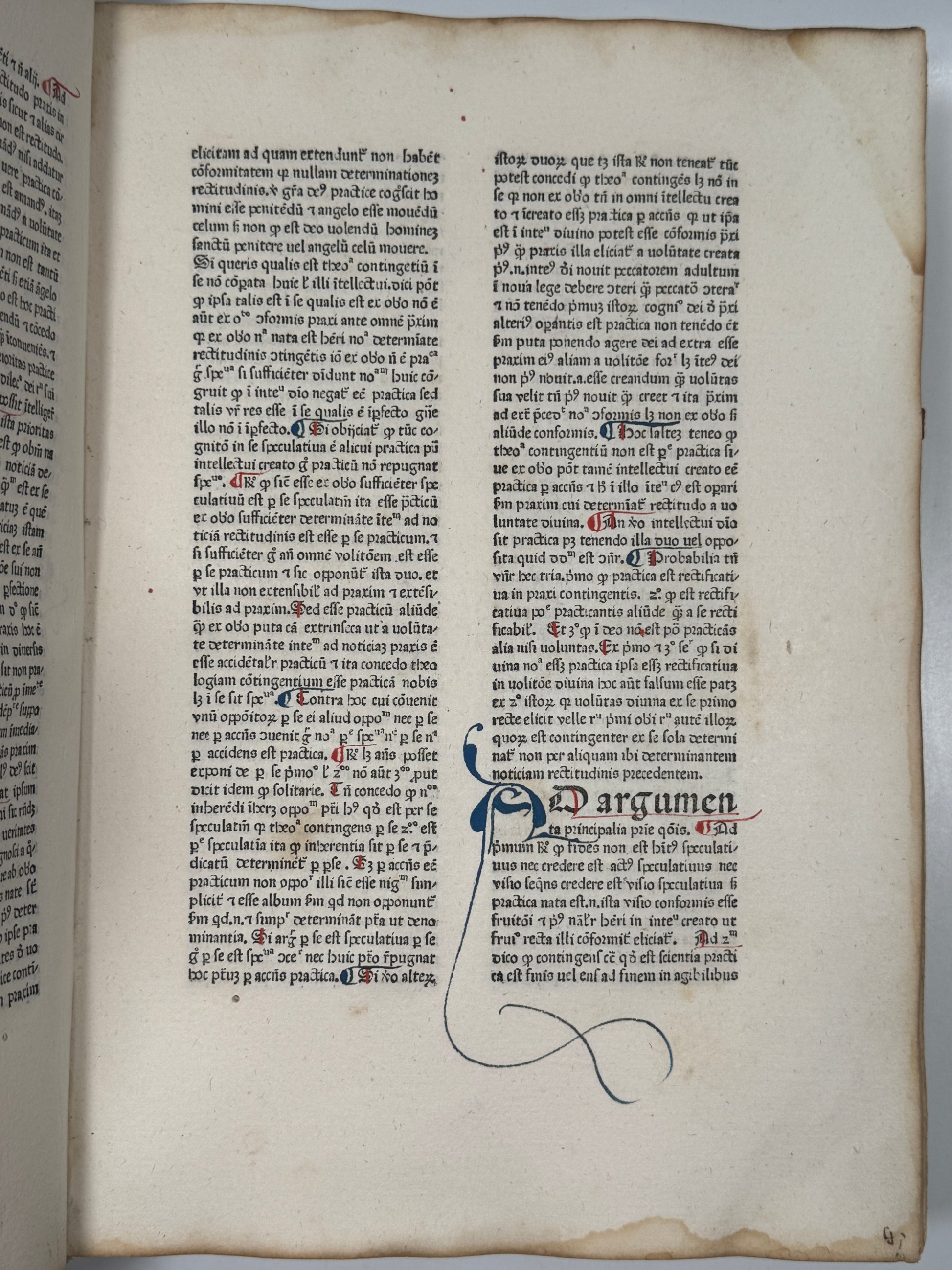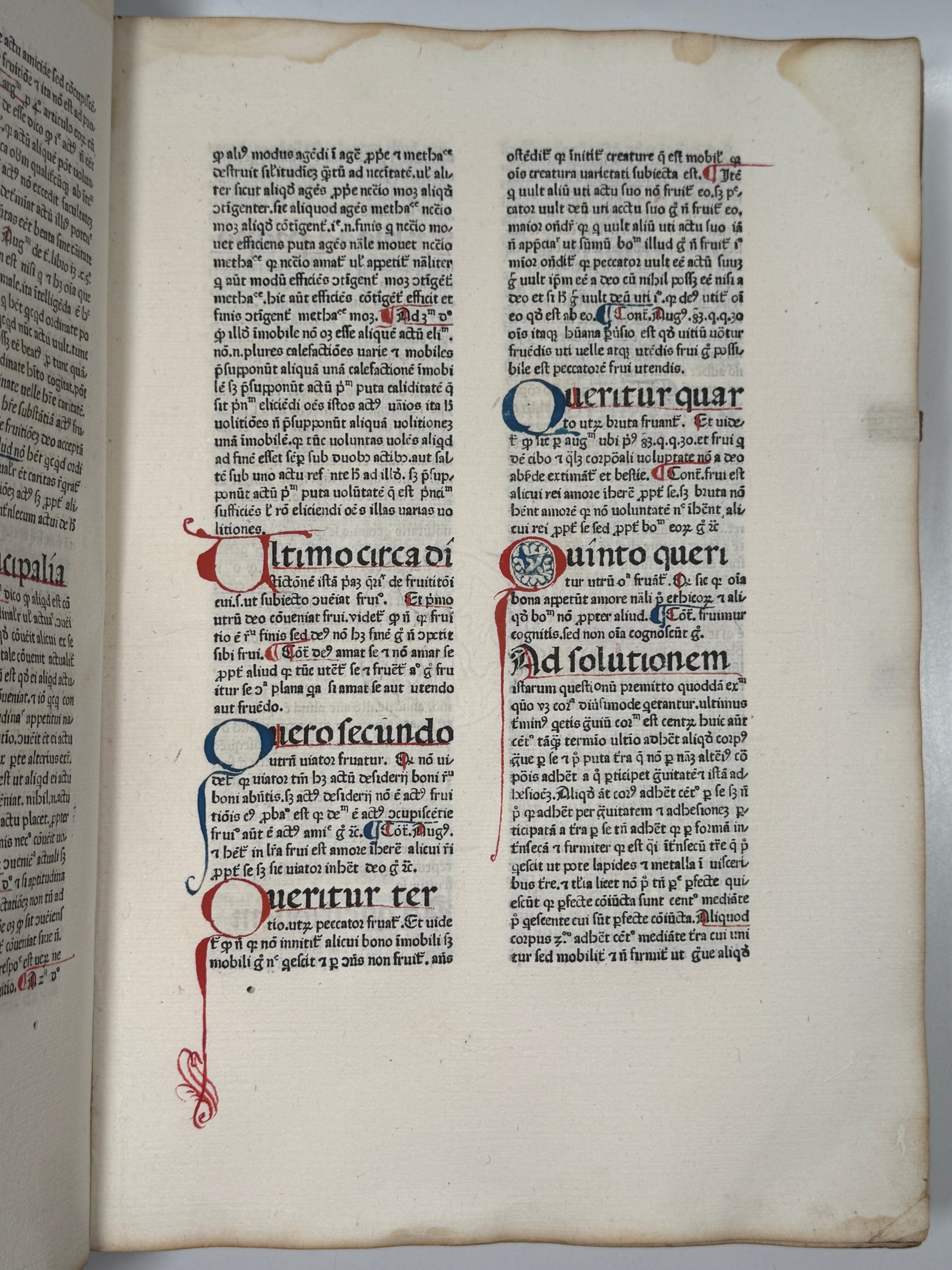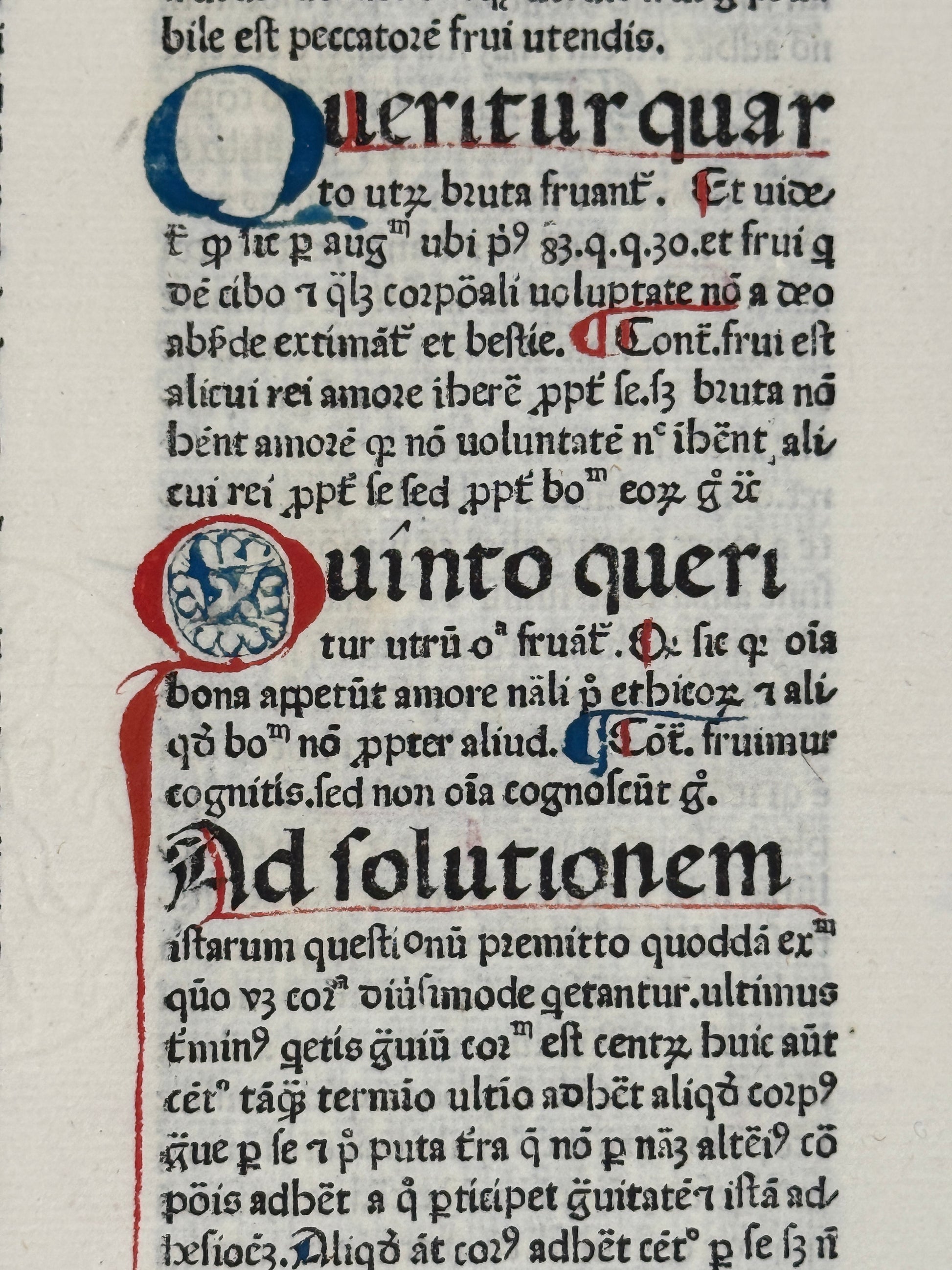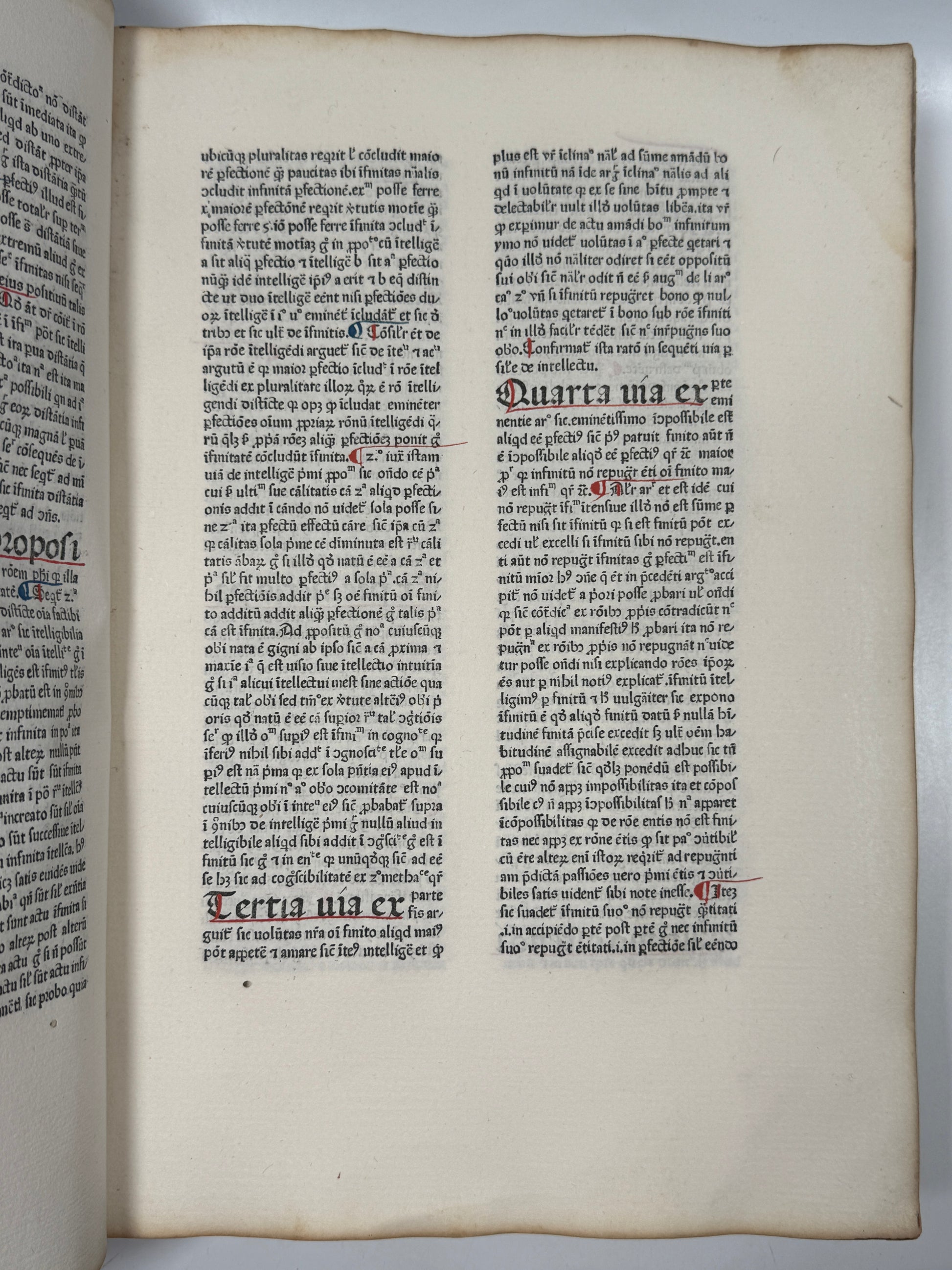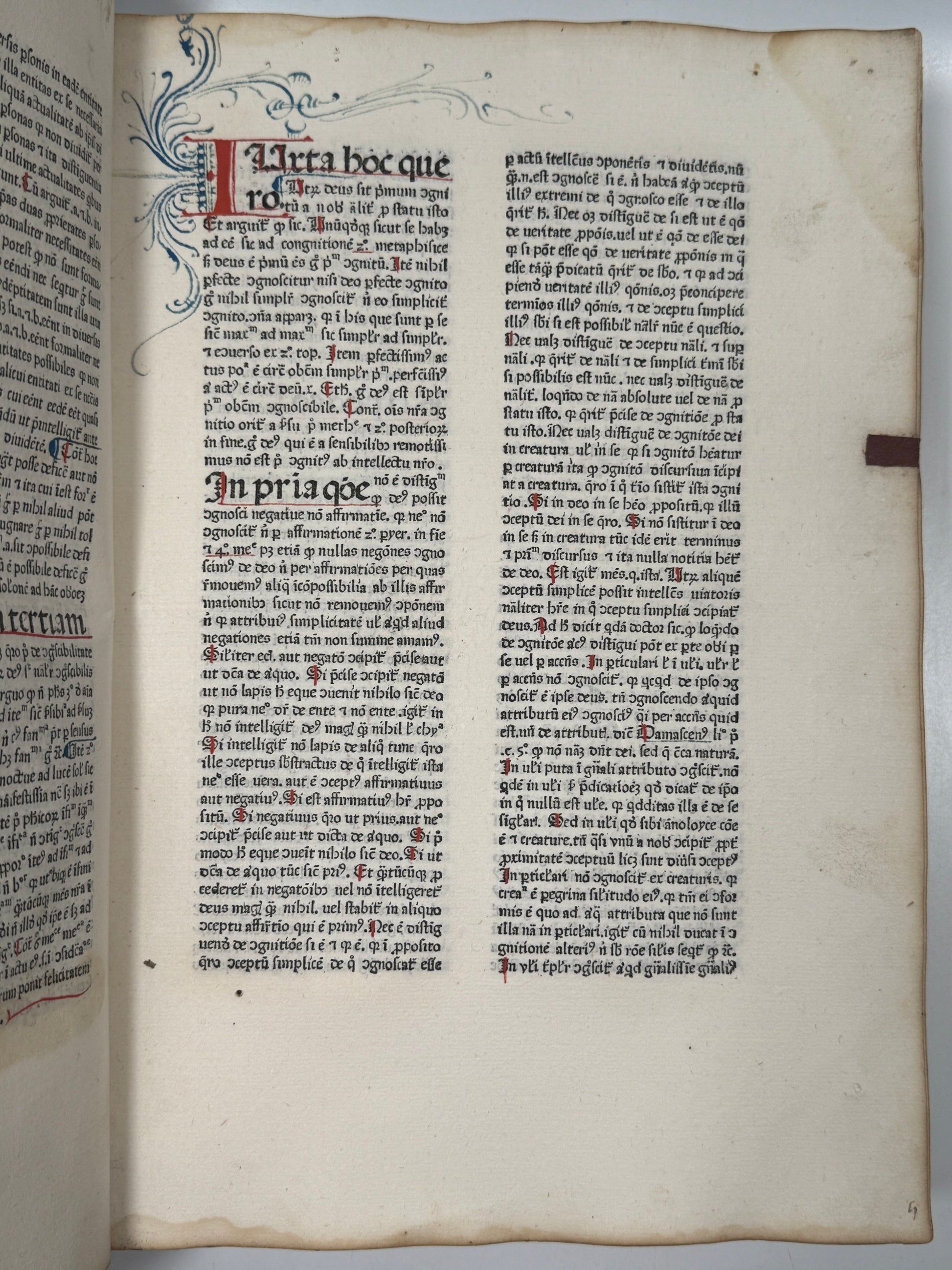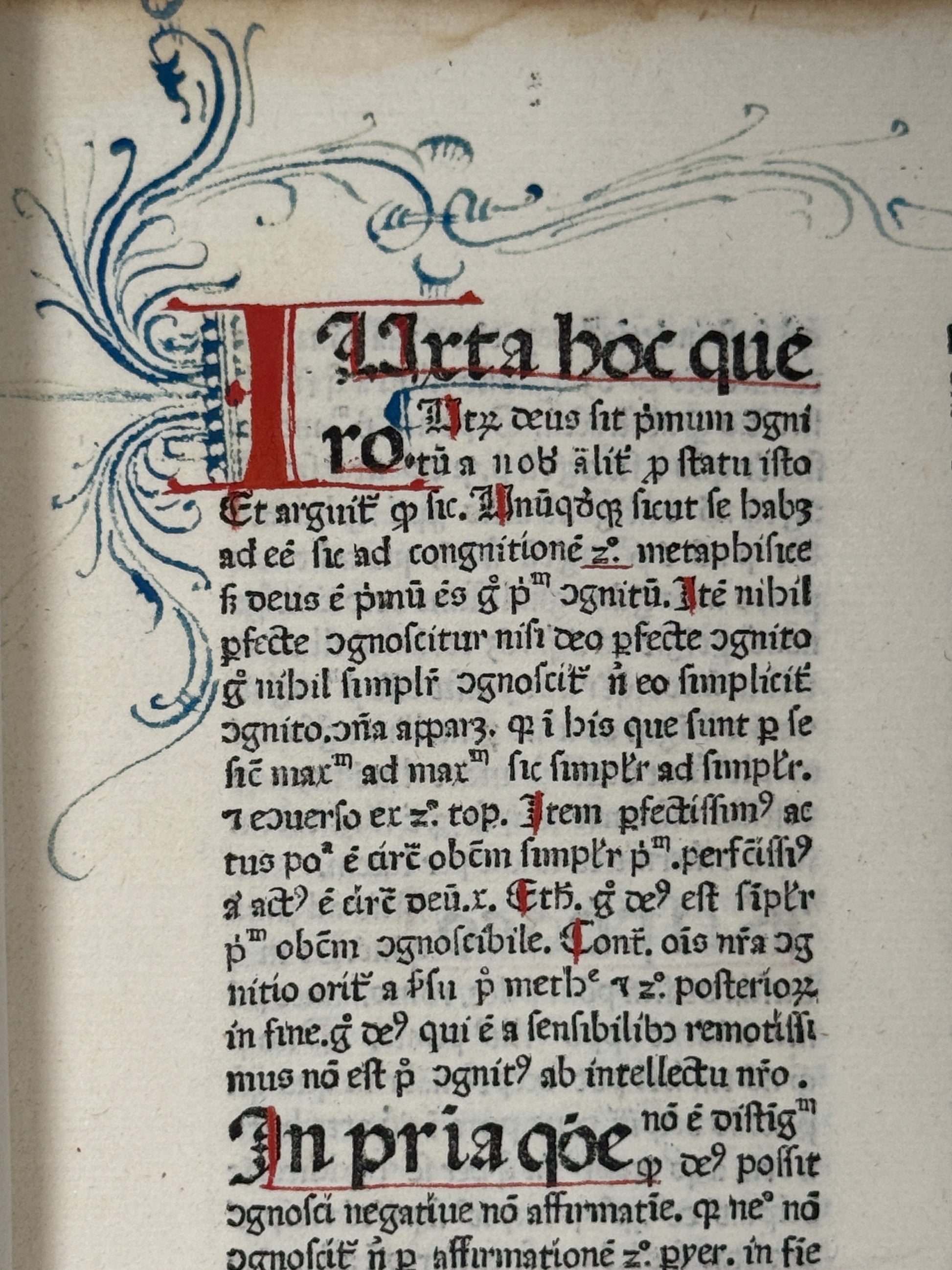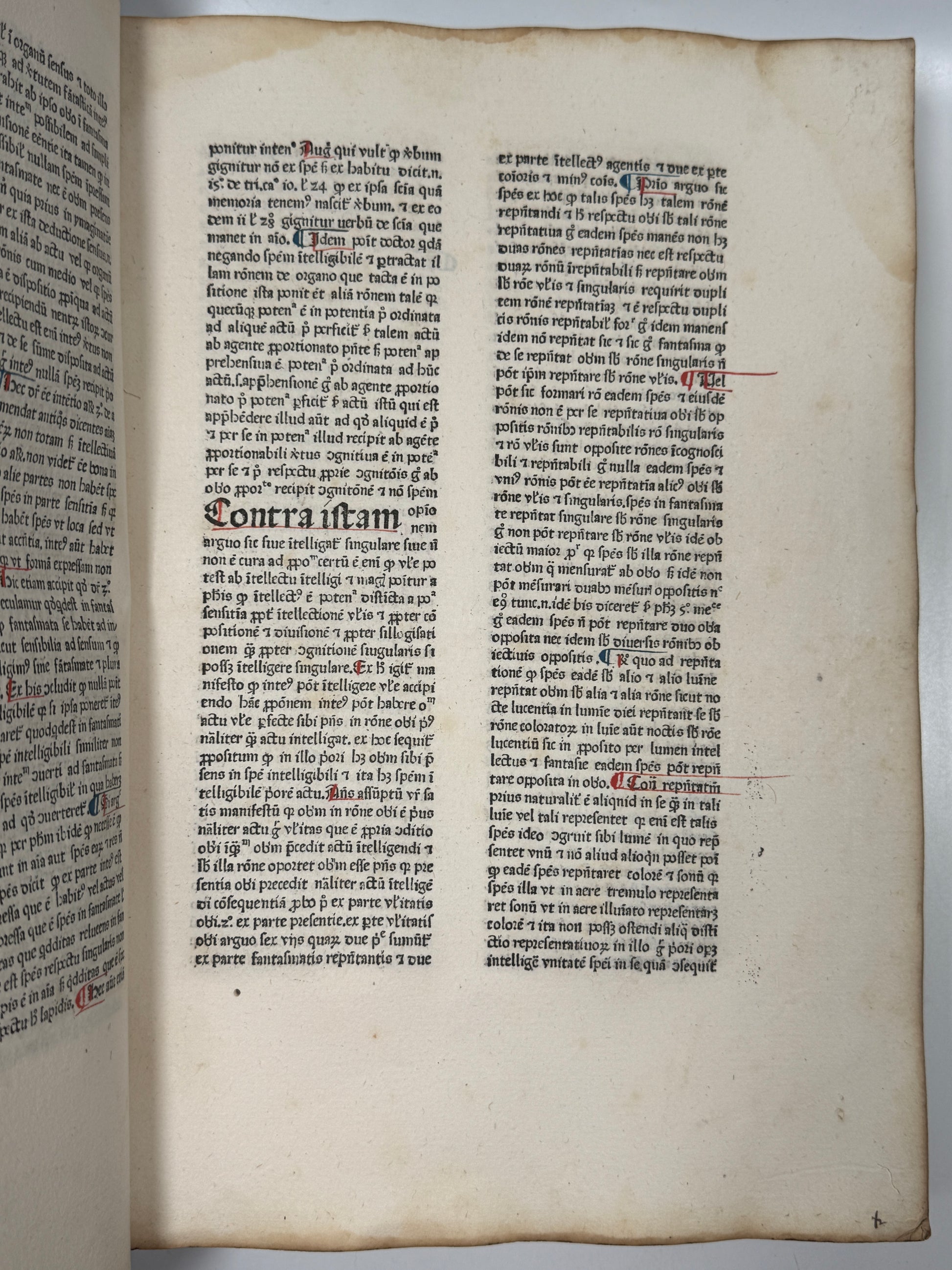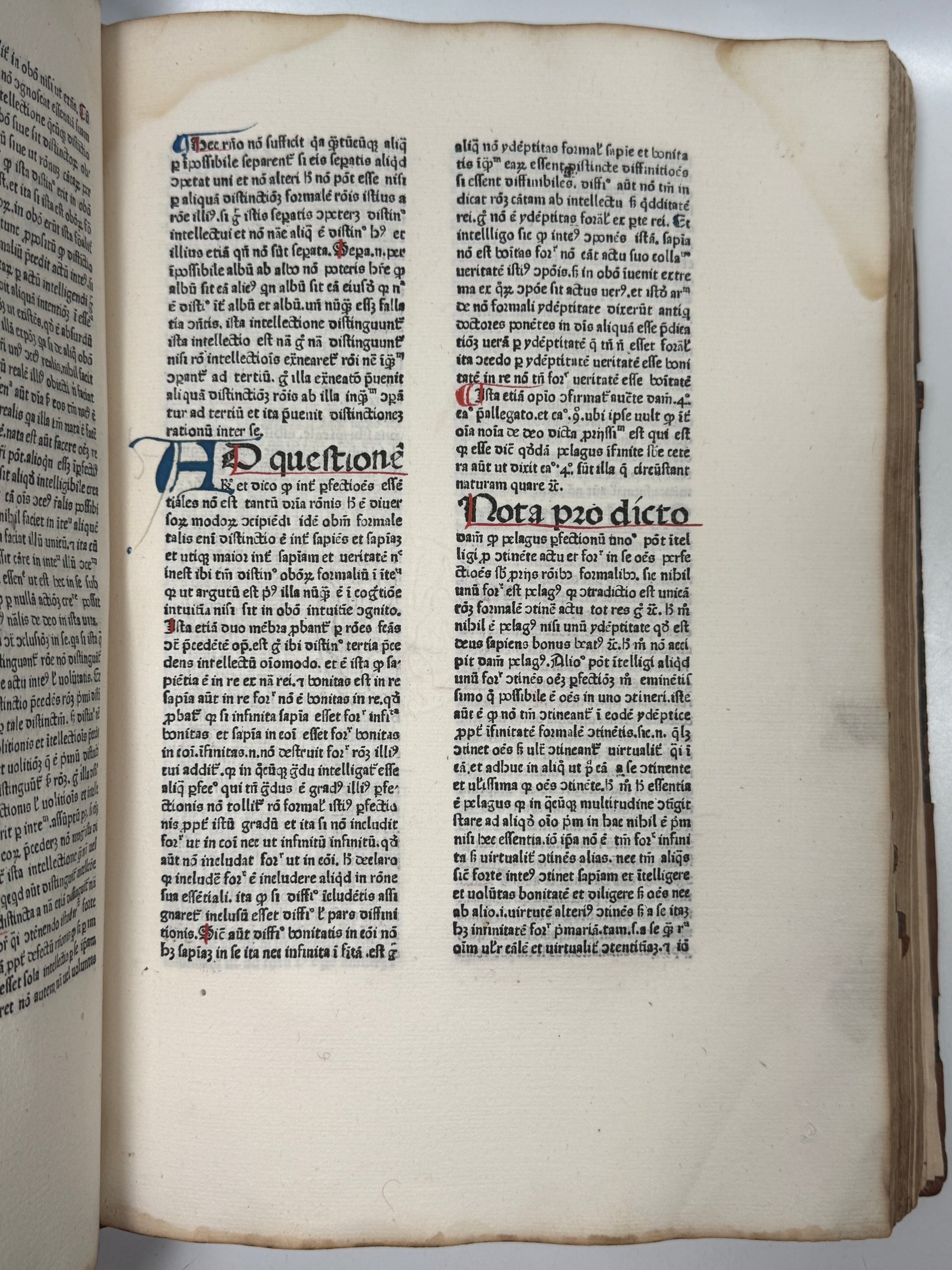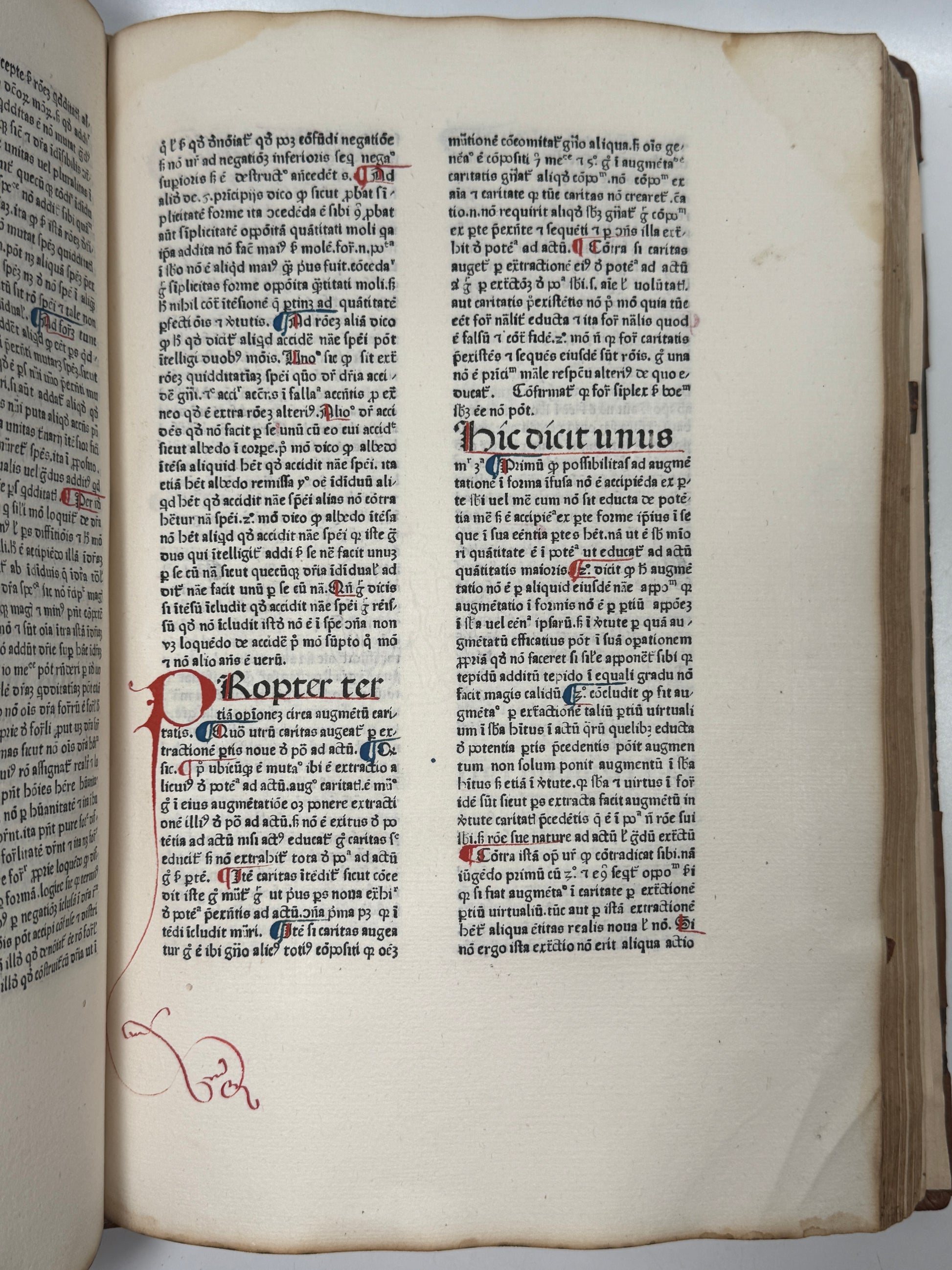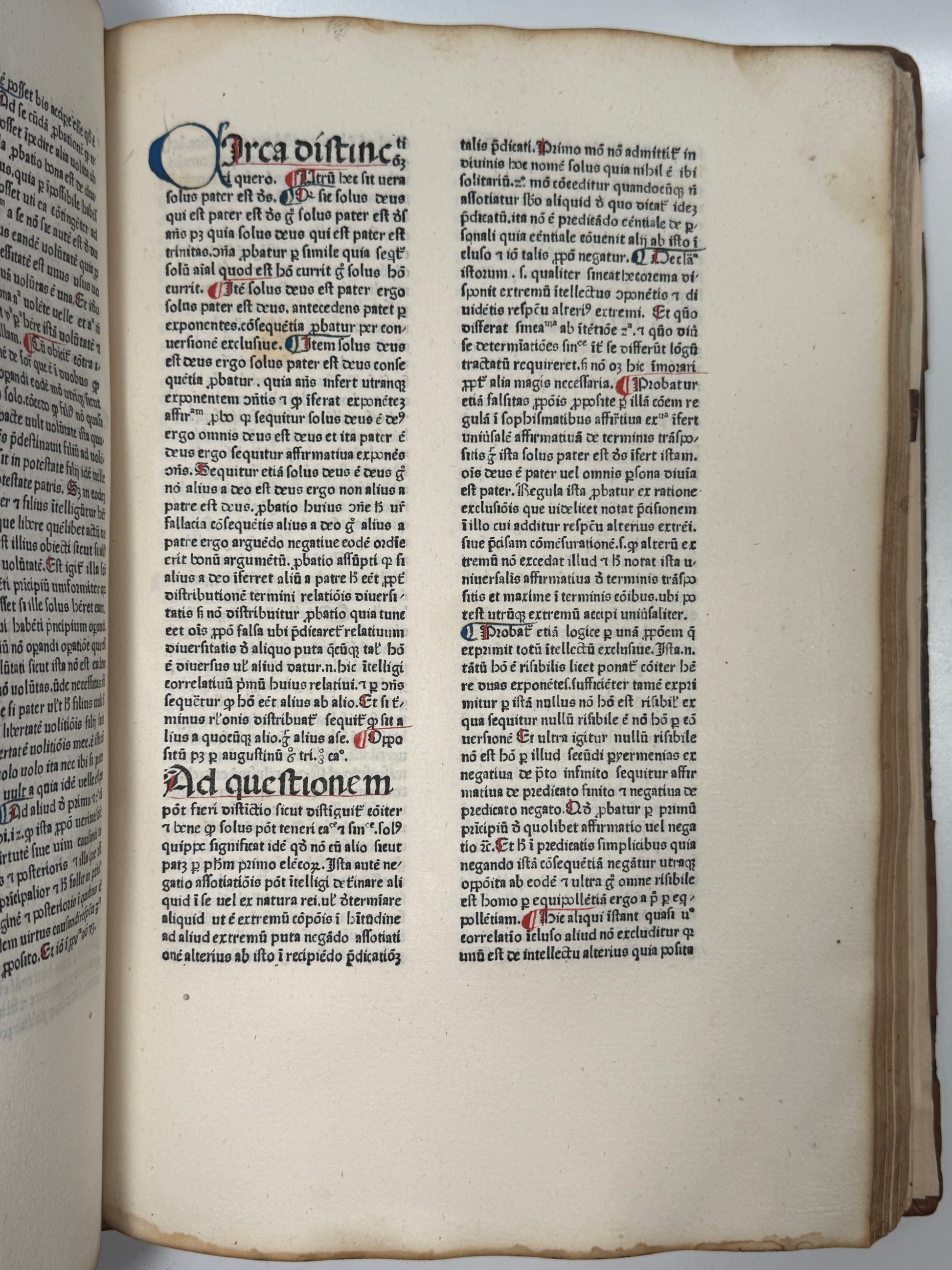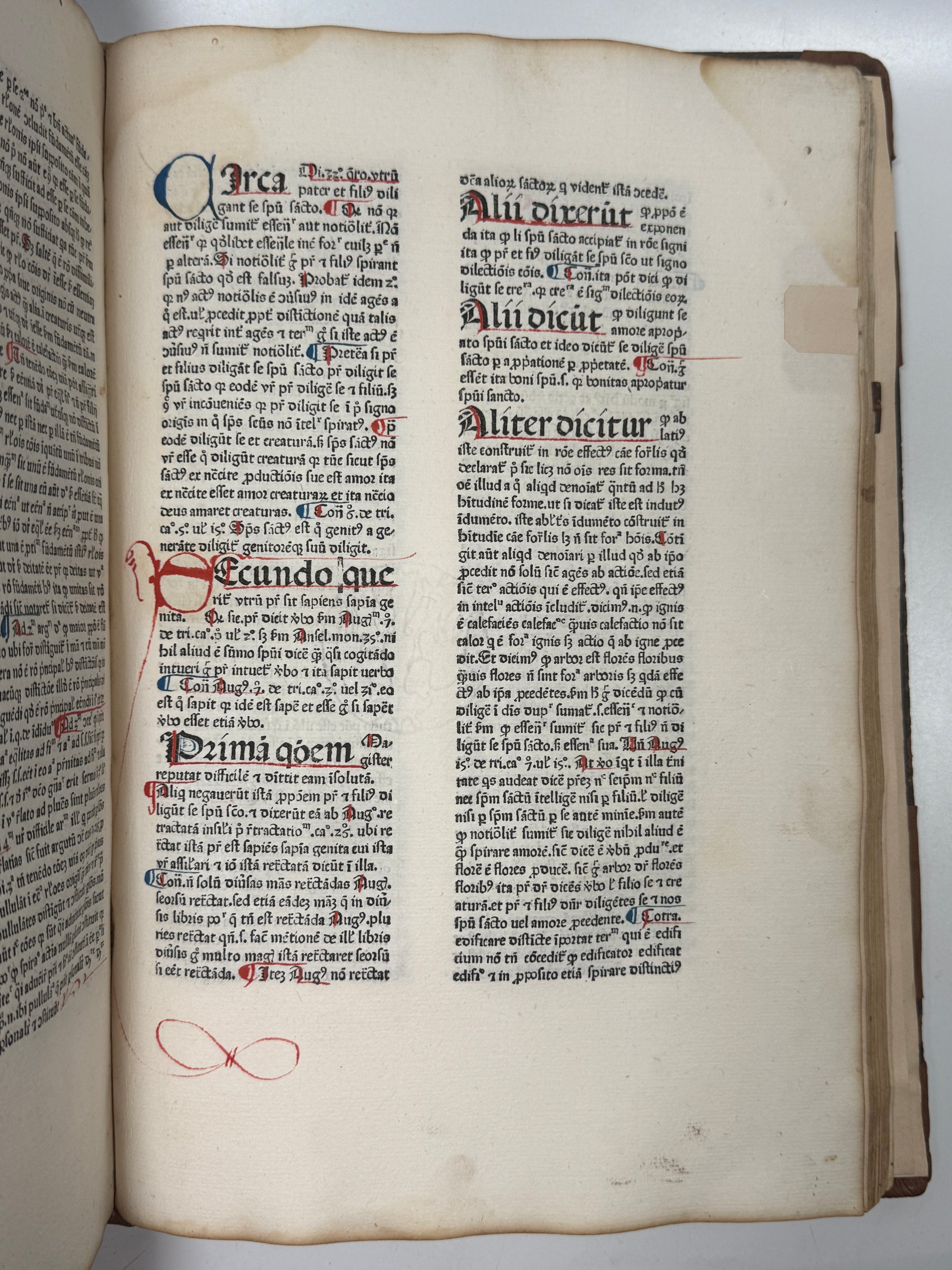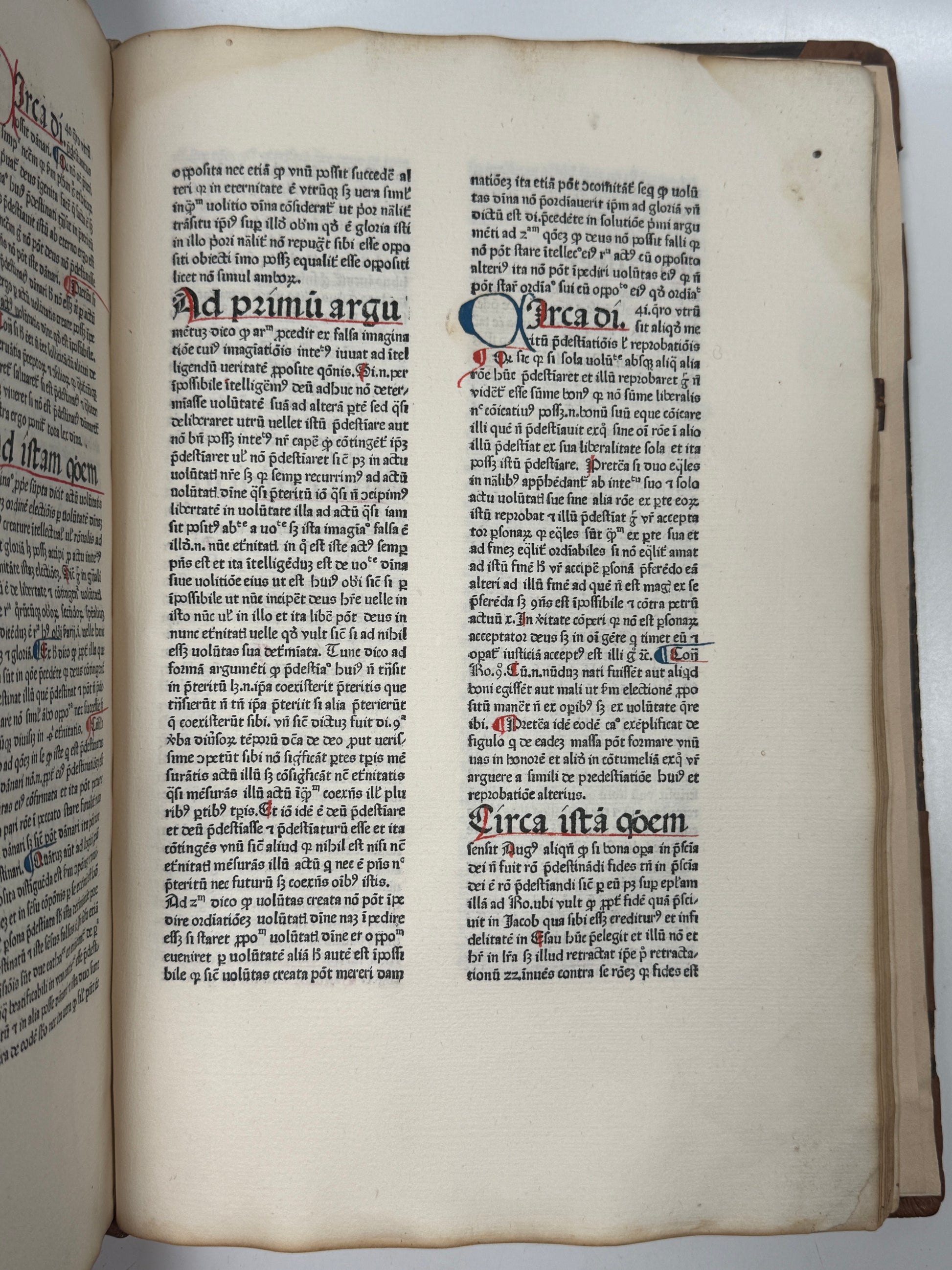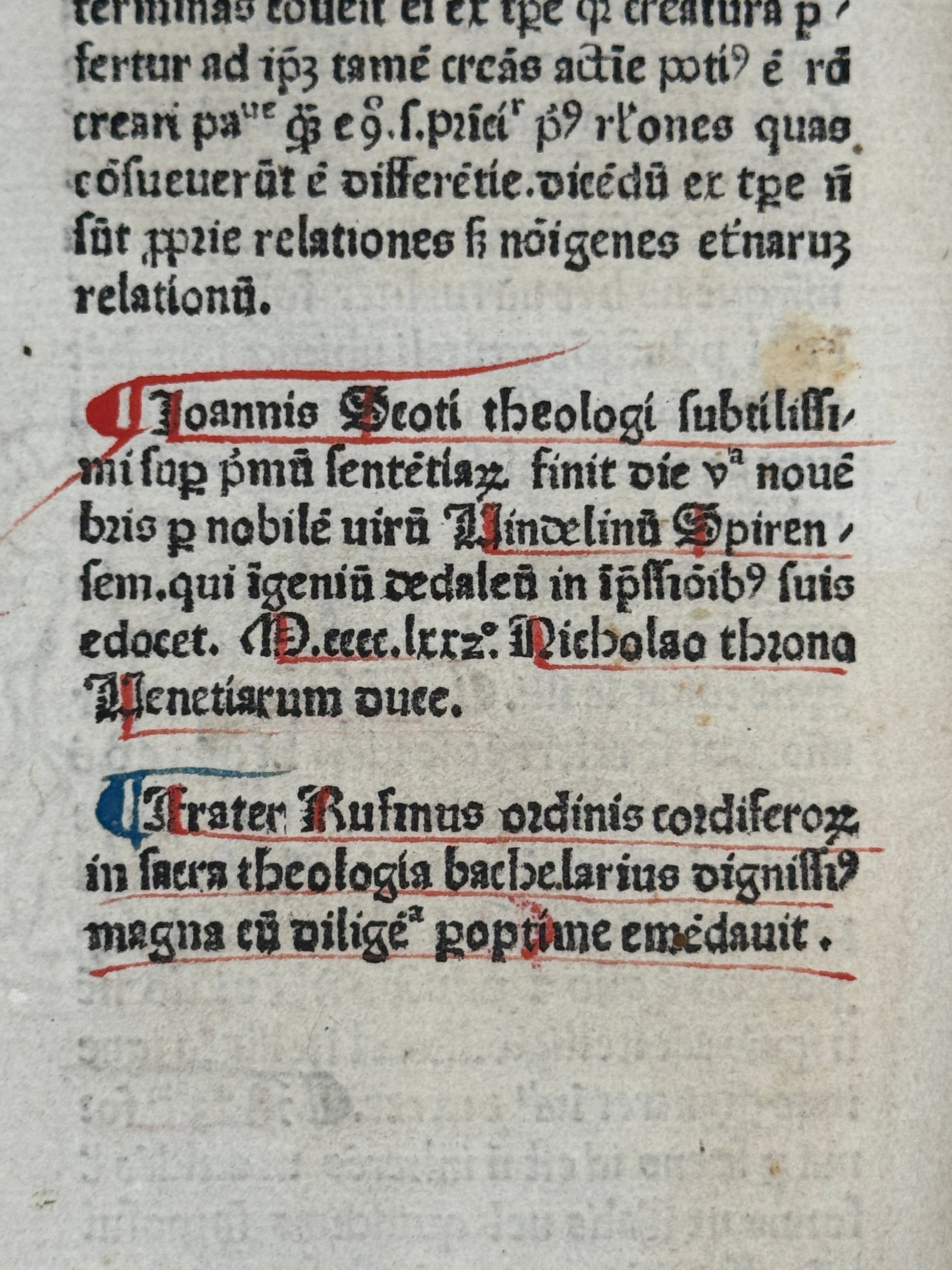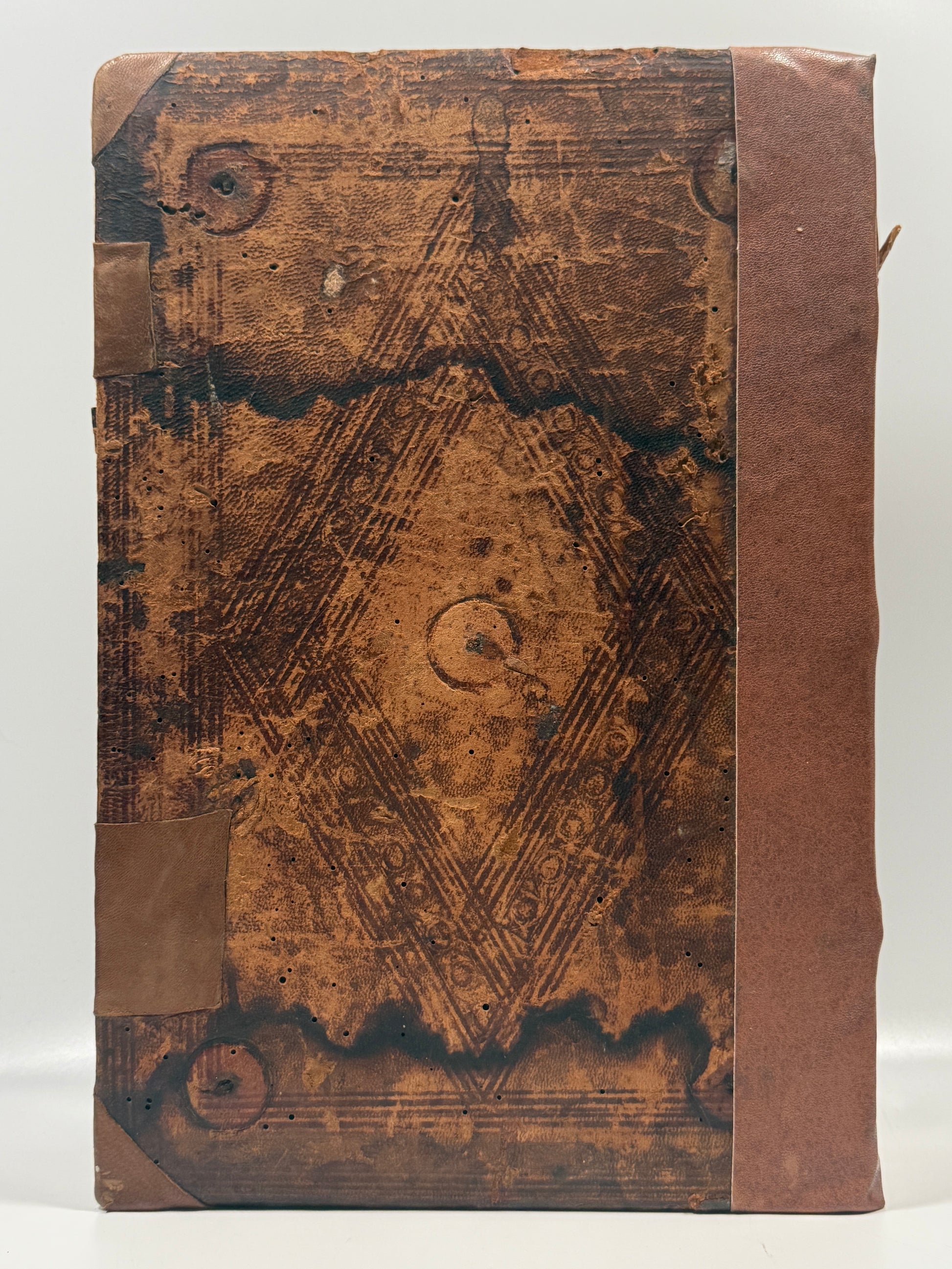A Milestone in British Intellectual History (1472): The Editio Princeps of John Duns Scotus — The First Printed Book by a Scottish Author.
A Milestone in British Intellectual History (1472): The Editio Princeps of John Duns Scotus — The First Printed Book by a Scottish Author.
Couldn't load pickup availability
[John Duns Scotus]. Quaestiones in primum librum Sententiarum Petri Lombardi. Edited by Brother Rufinus. Venice: Wendelin of Speyer, 5 November 1472, folio.
The editio princeps of John Duns Scotus' magnum opus, one of the most significant works of the Middle Ages, printed at the first press in Venice.
-------------------
THE FIRST PRINTED BOOK BY A SCOTTISH WRITER.
Predating the advent of printing in England by nearly four years, this 1472 editio princeps of Duns Scotus marks a pivotal moment in the transmission of British intellectual thought into print. It is the first printed book authored by a Scot, and has a very strong claim to being the earliest obtainable printed book securely attributable to a British author.
Though De proprietatibus rerum by Bartholomaeus Anglicus, an English-born writer, predates this edition by a few months (c.1471–72), that book remains entirely unobtainable in the market, with no recorded copies in private hands. Moreover, Bartholomaeus was an encyclopaedist with strong ties to France, while John Duns Scotus is undeniably central to Britain’s intellectual heritage and is one of the four most important philosophers of the High Middle Ages, alongside St Thomas Aquinas, St Bonaventure, and fellow Brit, William of Ockham (who first appeared in print in 1476). For a detailed investigation into the history of early British printing, see the article "Not Chaucer? Discovering the First British Author in Print (Before Caxton)", available on our website which details the first appearances in print of all British born writers of the incunable period.
-------------------
A foundational work of Western thought
This is the editio princeps of John Duns Scotus’ commentary on Peter Lombard’s Sentences, the foundational theological textbook of medieval universities. Written between c.1295 and 1300, the Quaestiones is among the most important and influential philosophical works of the Middle Ages.
Here, Scotus lays the foundations of what would become known as Scotist metaphysics. He introduces the doctrine of the univocity of being, asserting that "being" is predicated in the same sense of both God and creatures, departing from the analogical approach favoured by Aquinas. He also develops the formal distinction, a nuanced middle path between real and conceptual distinction, permitting multiple attributes (e.g., justice and mercy) within a single substance. Most famously, Scotus articulates the concept of haecceity (“thisness”), the principle that accounts for individuation: that which makes a being this particular being, and no other. This emphasis on irreducible individuality prefigures later philosophical developments, including Descartes’ cogito ergo sum and modern theories of personal identity. Far from a mere scholastic exercise, the Quaestiones inaugurates a philosophical system that profoundly shaped the trajectory of Western thought. Scotus' influence endured for centuries, and he was beatified relatively recently by Pope John Paul II.
As the inception point of one of the most distinctive metaphysical systems in the Christian tradition, the Quaestiones is an important work not only in theological history, but also in the broader history of philosophy. Its appearance in print in this 1472 edition marks a pivotal moment in the transition from manuscript culture to the typographic age, a significant monument of British intellectual culture and of European thought more generally.
-------------------
Printed at the first press in Venice
This edition was produced by Wendelin of Speyer at Venice’s first press. Wendelin had inherited the press from his brother Johann, who established it before dying in 1470. Among their significant productions were the editio princeps of Pliny’s Naturalis Historia (1469) and Cicero’s Epistolae ad familiares (1470). The Duns Scotus Quaestiones is a major achievement of this pioneering press and a high point in Wendelin’s legacy.
-------------------
A magnificent, wide-margined copy with painted initials and extensive monastic provenance.
A beautifully rubricated example, with a large painted opening initial containing coloured acanthus decoration, and alternating red and blue Lombard initials throughout, some with delicate fleuronnée-style extensions. The text block is notably fresh and wide-margined, preserving early manuscript quire signatures with minimal trimming.
The binding is contemporary blind-tooled calf over wooden boards, with early signs of metal furniture, and a manuscript title at the lower edge in a monastic hand, almost certainly from the now destroyed Carthusian Monastery of Ilmbach.
-------------------
Rarity
The ISTC (id00374000) records 46 institutional copies, only 3 of which are in the UK. The Gesamtkatalog der Wiegendrucke (GW) lists 48 institutional holdings, including fragmentary ones. GW also notes "at least 1 copy in private ownership," very likely this copy. This is the only copy known to have appeared on the market in over four decades. The last appearance, in 1983, likely refers to this very copy. By comparison, the second edition sold for £22,000 in Quaritch’s 2021 New York fair catalogue, and another was acquired by Yale University Library in 2001.
This 1472 first edition, however, is in every respect superior: printed by a foundational figure in Venetian printing, of far greater rarity and bibliographic significance, and of profound importance in British, especially Scottish, intellectual history. It is extremely unlikely that another comparable copy will appear on the market in the foreseeable future.
-------------------
Provenance
Originally with the Carthusian Monastery of Ilmbach, Bavaria, with 15th and 16th century inscriptions, likely its original purchaser. The book survived the 1525 Peasants’ Revolt, during which the monastery was destroyed by fire and rebuilt two years later. Likely rubricated and decorated at Ilmbach and shelved horizontally, as indicated by the manuscript title to the lower edge, possibly once a chained binding.
Subsequently owned by the Franciscan Monastery of St Elisabeth, Thuringia, in the 17th century, surviving the Thirty Years’ War, and later held at the Franciscan Monastery of Dettelbach in the 19th century, with their ownership stamp. Thereafter deaccessioned, likely the same copy that appeared on the market in 1983. In private hands since, in an important European collection, and now acquired by us with export license granted.
-------------------
Size: 235 x 350 mm (approx.)
Condition
[(1), (π)¹, [2], (π)¹, a², b¹⁰, c–d⁸, e¹⁰, f–g⁸, h¹⁰, i–k⁸, l¹⁰, m–n⁸, o¹⁰, p–q⁸, r¹⁰, s⁸, t–u¹⁰, x–y⁸, z¹⁰, A⁸, B–C⁶, D⁷, (1)]
Collates 223 of 224 leaves, lacking only the final blank and thus textually complete. This copy includes an additional two-leaf Prologue not called for in ISTC or other standard bibliographies, and absent from the digitised copy at the Biblioteca Nazionale Centrale di Roma. While 224 leaves are standard, this copy comprises 225 leaves (excluding later blanks), despite the final blank still lacking.
Printed in Gothic type, double column, 46 lines per page. Finely rubricated throughout with alternating red and blue Lombard initials. The opening initial is exquisitely painted with two acanthus tendrils in green, turquoise, yellow, red, and blue.
Internally exceptionally fresh and bright, with wide margins and excellent preservation. A light dampstain is confined to the upper blank margin across slightly more than half the text block, not affecting the text. Early manuscript quire signatures are preserved at the lower corners of many leaves, with minimal trimming of the page block.
Preliminary blank remounted, preserving the majority of the leaf and retaining a contemporary inscription at the head of its recto. The first leaf of the Prologue has a repair at the foot (not affecting text), along with several early inscriptions and a small blue stamp. Minor marginal repairs to x2, y3, and C1 (not affecting text), and slightly larger repairs to A6 and D7, likewise outside the text area. B6, a blank, is present. A wormhole track affects the bottom margin of y3–y5 (three leaves only), far from the text. Minor worming also present to the final quire. Sixteen small leather fore-edge tabs remain for place-marking, with signs that a few others are now lost.
Contemporary blind-tooled calf over wooden boards, rebacked with a defective early MS title retained to upper spine. The bottom edge of the text block inscribed with the title in a likely monastic hand, indicating horizontal storage. Neatly rebacked with corners sympathetically restored. The binding shows moderate rubbing and some discolouration, with signs of former metal fittings, possibly once a chained binding, but remains sound and attractive overall. The blind-tooling design is lozenge shaped inside a rectangular panel; the front board with an "I" shape to the front board, probably from a clasp plate or hasp used to secure the book shut with the original metal furniture. Some worming to binding as expected.
This is not only the first appearance in print of one of the greatest minds of medieval philosophy, but also a cornerstone in the history of British intellectual achievement, surviving in an outstanding state of preservation, and may well be the only surviving copy in private hands.
[GW 9079; USTC 995164; Goff D374; ISTC id00374000; Hain 6422; Pell 4456; Bod-inc D171; BMC V159; BSB Ink D300]
References:
"Recent Acquisitions Briefly Noted". (2001). The Yale University Library Gazette, 75(3/4), 196-197.
Williams, T. (2021). "John Duns Scotus". In E. N. Zalta (Ed.), The Stanford Encyclopedia of Philosophy (Fall 2021 Edition). Stanford University.
Febvre, L., Martin, H.-J. (2010). "The Coming of the Book: The Impact of Printing, 1450-1800" (D. Gerard, Trans.). Verso. (Original work published 1958)
Addendum: Priority in British Print History
Although De vita et moribus philosophorum was printed c.1470 and once attributed to Walter Burley, modern scholarship dismisses this attribution. Likewise, Johannes de Sacrobosco’s De sphaera mundi, printed slightly earlier in 1472, cannot be definitively tied to Britain, and the editio princeps survives in only three institutional copies.
The present volume stands as the earliest work by a Scottish author to be printed, and the earliest obtainable printed book by a British author. While absolute certainty is impossible, our extensive bibliographical survey confirms this edition's precedence.
Michael Scotus' Liber physiognomiae (1477) is the next securely datable printed work by a Scottish author. For a complete analysis and chronological list of British authors printed before 1501, see our full article "Not Chaucer? Rethinking the First British Author in Print," available on our website.
